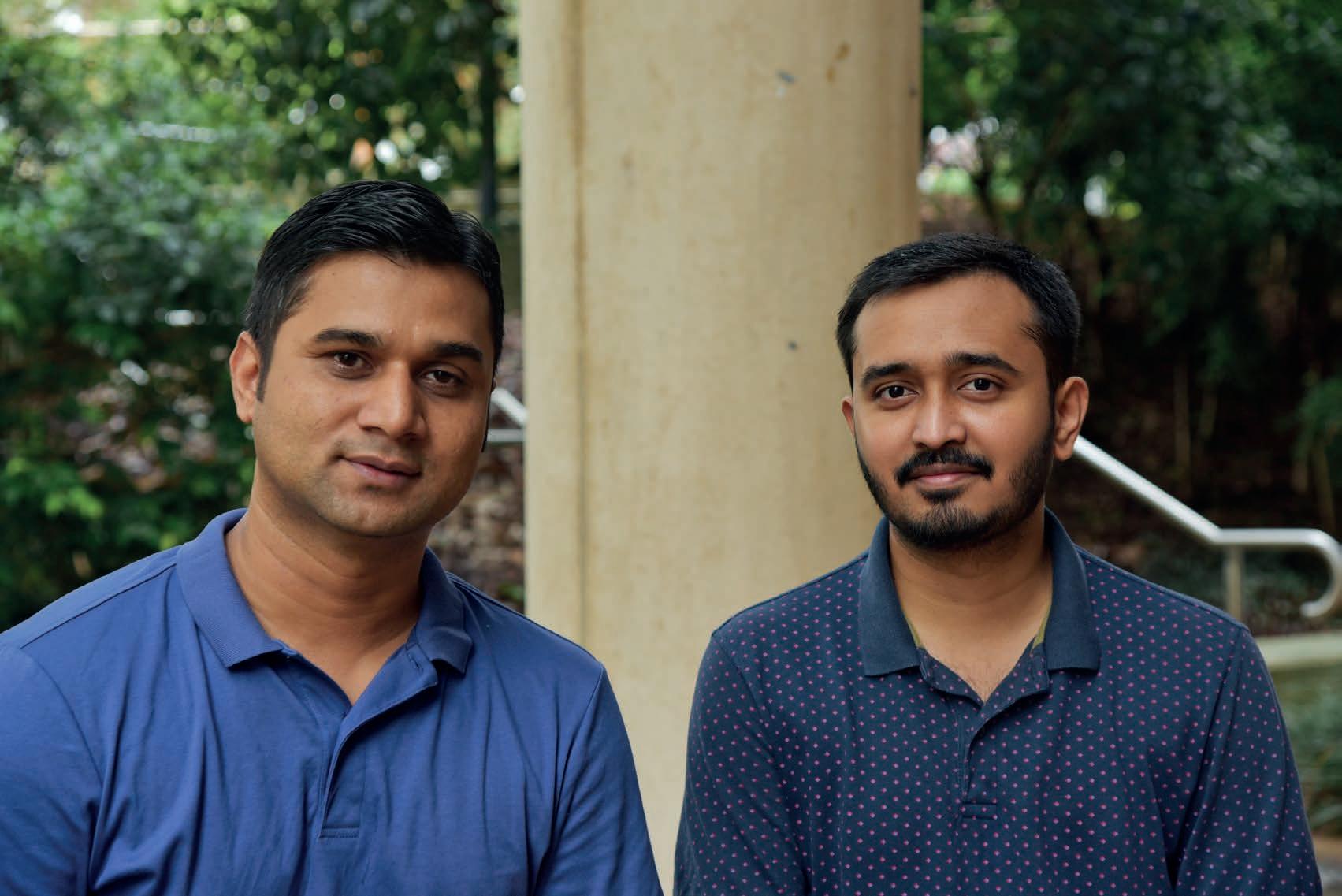
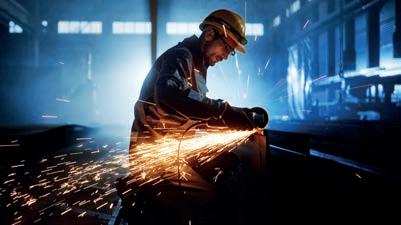
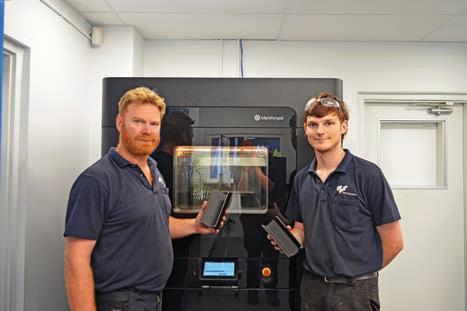


NEXT GENERATION medical implants manmonthly.com.au MANAGEMENT >> TECHNOLOGY >> SOLUTIONS >> INSIDE >> Exit planning for businesses 32 Additive manufacturing for WA 29 JULY 2023 Developing augmented reality from Australia 34 Official Industry Partners
twitter.com/Manmonthly facebook.com/Manmonthly linkedin.com/showcase/manufacturer’s-monthly/
CEO: John Murphy
Chief Operating Officer: Christine Clancy
Managing Editor: Syed Shah
Editor: Josh Farrell joshua.Farrell@primecreative.com.au
Journalist: Mignon D’Souza mignon.dsouza@primecreative.com.au
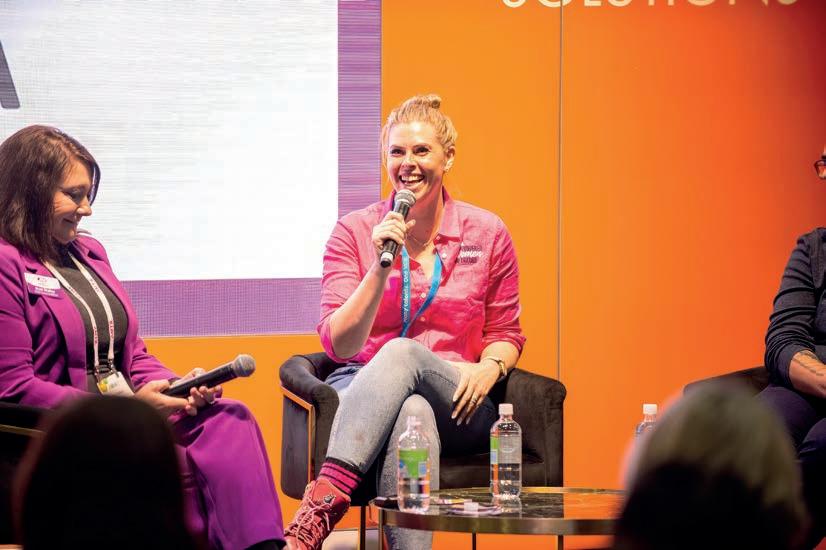
Production Coordinator: Michelle Weston michelle.weston@primecreative.com.au
Art Director: Blake Storey
Design: Kerry Pert, Tom Anderson, Louis Romero
Sales/Advertising: Danny Hernandez
Ph: 0431 330 232 danny.hernandez@primecreative.com.au
Subscriptions
Published 11 times a year
Subscriptions $140.00 per annum (inc GST)
Overseas prices apply
Ph: (03) 9690 8766
Copyright
Manufacturers’ Monthly is owned by Prime Creative Media and published by John Murphy. All material in Manufacturers’ Monthly is copyright and no part may be reproduced or copied in any form or by any means (graphic, electronic or mechanical including information and retrieval systems) without written permission of the publisher. The Editor welcomes contributions but reserves the right to accept or reject any material. While every effort has been made to ensure the accuracy of information, Prime Creative Media will not accept responsibility for errors or omissions or for any consequences arising from reliance on information published.
The opinions expressed in Manufacturers’ Monthly are not necessarily the opinions of, or endorsed by the publisher unless otherwise stated.
© Copyright Prime Creative Media, 2023
Articles
All articles submitted for publication become the property of the publisher. The Editor reserves the right to adjust any article to conform with the magazine format.
Head Office 379 Docklands Drive
Docklands VIC 3008
P: +61 3 9690 8766 enquiries@primecreative.com.au www.primecreative.com.au
Sydney Office Suite 3.06,


Chandos Street
Leonards NSW 2065, Australia
Manufacturers’ Monthly Contents
In the July edition of Manufacturers’ Monthly we unpack a variety of trends and challenges facing Australian manufacturing, from tax incentives to securing supply of critical parts. An incredible development in the medical implants space is this months engineering focus. University of Queensland researchers have created a gold sensor for implants which
promises to drastically improve efficiency and reliability of implantable medical devices. We sat down with the two reserachers behind the development to learn more about it and how it is expected to be used.
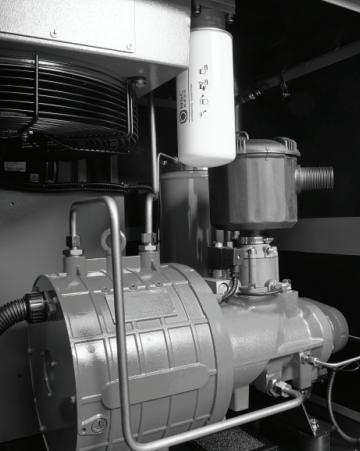



Elsewhere, RSM breaks down exit planning for manufacturers and what owners often forget when setting up a succession plan.

4 Editor’s Note 6 Comment 14 News 24 Engineering Focus 29 Additive Manufacturing 32 Financial Services 34 Augmented Reality 37 AMW Wrap 40 What’s New 42 Last Word For daily news visit manmonthly.com.au Inside JULY 2023 24 Behind the cover NEXT GENERATION medical implants manmonthly.com.au MANAGEMENT >> TECHNOLOGY >> SOLUTIONS >> INSIDE >> Exit planning for businesses 32 Additive manufacturing for WA 29 JULY 2023 Developing augmented reality from Australia. 34 Official Industry Partners T&C Only organizations with relevant use cases qualify for the Complimentary 3D Printed Part at the discretion of the Markforged Application Engineer. By subscribing to the Complimentary 3D Printed Part campaign you agree for Markforged to use the part for marketing purposes. Offer valid in Australia. Get your Complimentary 3D Printed Part* Are you looking to innovate faster and reduce supply chain issues by 3D printing everything from prototypes to end-use parts? We got you covered! At Markforged we are on a mission to bring industrial manufacturing to the point of need. To help manufacturer reduce lead time we are offering a Complimentary 3D Printed Part*, for a limited time only, to encourage manufacturers to improve their production processes. See for yourself the unmatched surface finish, strength and precision of our 3D printed parts in metals and continuous-fiber reinforced composites. Claim your Complimentary 3D Printed Part by simply scanning the QR code and filling out the form. Our Engineers will be in touch!
37
1-9
St
P:
Printed by: Manark Printing 28 Dingley Ave Dandenong VIC 3175 Ph: (03) 9794 8337
+61 2 9439 7227
manmonthly.com.au
2 JULY 2023 Manufacturers’ Monthly manmonthly.com.au
CAPS’ NEW RANGE OF ENERGY EFFICIENT ROTARY SCREW COMPRESSORS
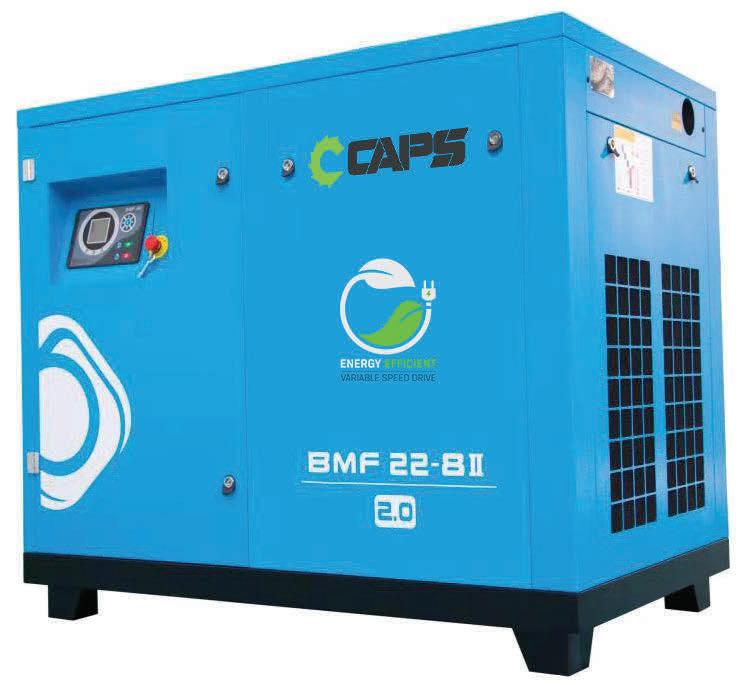


Introducing our new BMF range of rotary screw compressors with variable speed drive and permanent magnet motors. Enjoy maximum energy efficiency and performance while reducing operating costs.
• 15 to 45 kW
• Kubota engine

Editor’s Note
JOSH FARRELL – Editor, Manufacturers’ Monthly
Looking to the future
IT has been an exciting time for the manufacturing community. I was lucky enough to attend all four days of the Australian Manufacturing Week, where I was introduced to a range of industry professionals, all sharing similar verve for manufacturing innovation and progress.
It was recognised by a range of manufacturers that it is important to invest in fresh initiatives to better support its employees and solidify their businesses.
Maria Christina,
national manager manufacturing and wholesale at Commonwealth Bank shed light to the AMW crowd on CBA’s annual publication examining the key trends shaping the manufacturing sector.

The Manufacturing Insight Report highlighted the resilience of our industry for a range of challenges it has faced over recent years. Eighty four per cent of manufacturers involved believe they adapted well or extremely well to pandemic induced opportunities and challenges. These challenges included a drop in revenue during the pandemic along with labour shortages but also an opportunity for a number of manufacturers to supply more of the local market, with supply chain issues impacting across the board.
Manufacturers invested in an average of 5.1 initiatives in their businesses. The most common were employee engagement, strengthening relationships with suppliers and partners to bolster supply chains, and investing in manufacturing or processing equipment and technologies to support growth.
The report took the opportunity to survey the expectations of the industry for the future, too.
The majority of manufacturers expect domestic and global economies to strengthen over the coming 12 months, with the largest businesses by far the most optimistic. Against this constructive backdrop, 65 per cent of manufacturers will concentrate on growth in the coming year, and 32 per cent seek to maintain revenues.
Manufacturers have implemented a broad array of sustainability initiatives,
and plenty more are in the pipeline. Several strategies have clear economic and efficiency benefits, while others extend beyond the organisation to encompass the supply chain, such as ethical procurement practices and using more sustainable materials in production.
However, it is manufacturers’ workplaces and people that are the most significant focus. More than 75 per cent of manufacturers are improving workplace safety and supporting employees’ well-being while also promoting an inclusive and diverse culture. The largest manufacturers are leading the way in extending the people-related initiatives to addressing and eliminating social issues within their organisation and across their supply chains.
The report uncovers a number of trends for manufacturers but there is a clear focus on people. As all industries struggle with a labour shortage, manufacturing is particularly hamstrung when compared to other sectors due to a lack of flexibility for employees,
employers will have to get clever to retain good staff.

It will be an interesting 12 to 24 months as businesses become increasingly resourceful with finding ways to retain employees. Hopefully, will see the industry as a whole grow.
I want to take the opportunity in my first editor’s note to show my appreciation for outgoing editor, Billy Friend and his tireless work and dedication to growing the Manufacturing space and diligently reporting on it in his time as editor of this magazine.
He has been an incredible advocate to the wider industry and his knowledge has been invaluable in setting up what will hopefully be a seamless transition of editors, allowing me to continue his fantastic work.
This magazine plays a pivotal role in sharing information within the manufacturing space while also advocating for the growth of the industry as a whole; I will strive to continue this tradition with every story that is put on these pages.
4 JULY 2023 Manufacturers’ Monthly manmonthly.com.au

Comment
How industry can realise the benefits of advanced technology
THE trade of welding conjures up images of dirty, dark workshops full to the brim with traditional tools and machinery prone to throwing off sparks and fumes.
But, with the advent of automation, robots, cobots and a range of other advanced welding technologies and techniques, this perception is becoming more and more outdated. Welding is a far less dangerous and arduous job than ever before. Increasingly, Australia’s worldclass welding workshops are light and bright, and fitted-out with some of the most advanced technology available. Weld Australia—the peak body representing the welding industry in Australia—can help welders and fabricators realise the benefits of these advanced welding technologies.
The power of industry 4.0, robots and cobots
Automation, Industry 4.0, robotics and collaborative robots are changing the way the welding and manufacturing industries work.
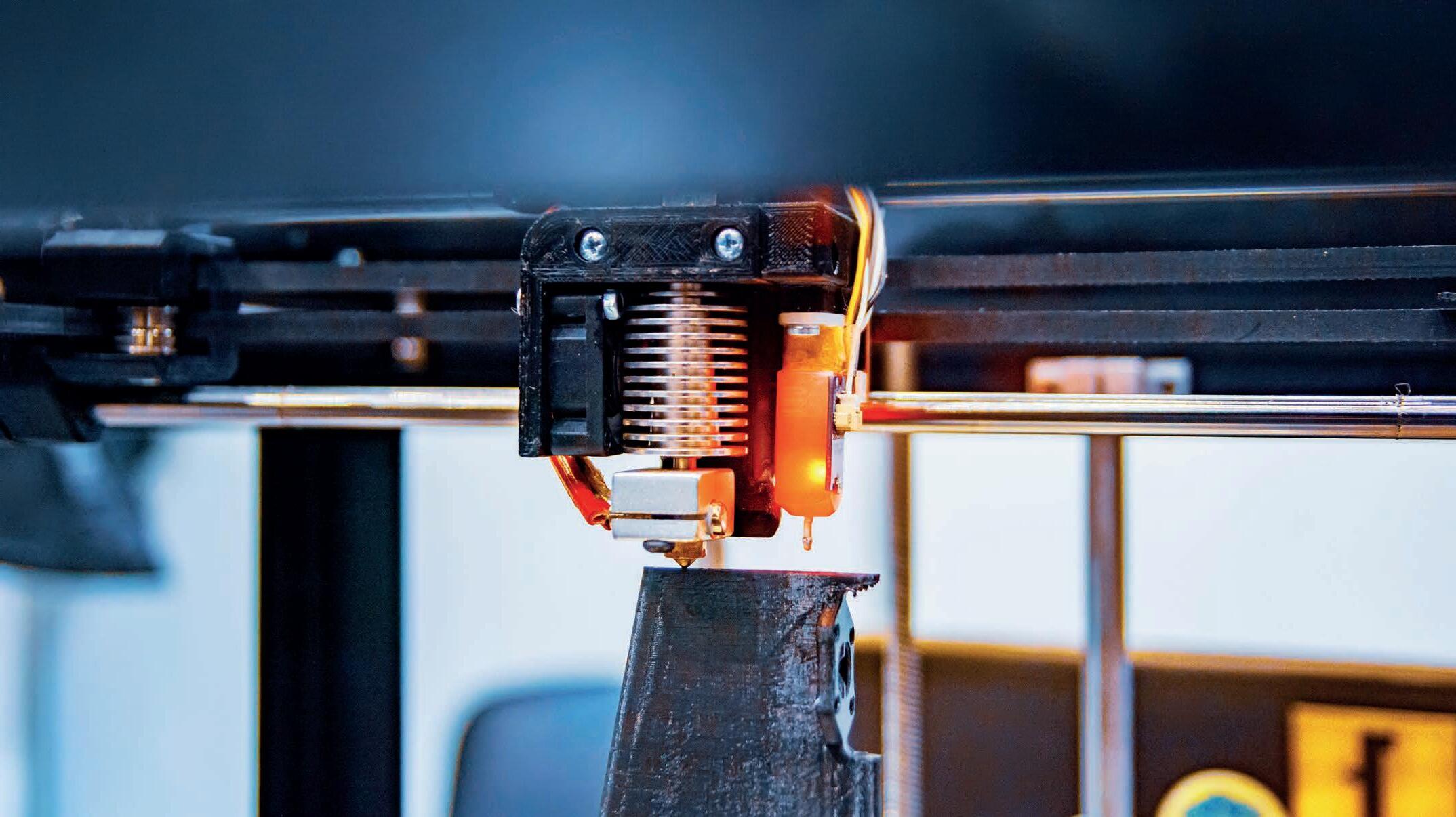
Cobots are specifically designed to share the workspace with human beings, making automation easier for businesses of all sizes, particularly SME’s. Cobots are generally versatile, smaller, lightweight, require relatively little space, and are much easier to program than their industrial counterparts. They can also capture large volumes of data that can be deployed in areas such as predictive maintenance. Weld Australia can help fabricators connect with cobot suppliers, and provide training related to the integration and use of cobots.
All these technologies offer a raft of benefits, from improved productivity, quality and repeatability, through to safer working conditions and greater job satisfaction. Increasingly, advanced technology is becoming a critical factor in the success of globally competitive welders, fabricators and manufacturers. And yet, Australia’s adoption rates lag well behind other advanced economies.
Improved productivity and profitability
To ensure their global competitiveness, businesses are investigating ways to save money and reduce their overheads. The best way to do so is by undertaking operational efficiency improvements that help reduce or eliminate redundancies, errors, bottlenecks and waste.
Industry 4.0 methodologies, robots and cobots play an essential role in creating lean manufacturing processes. The right type of technology can help eliminate workflow delays and duplications and accelerate entire processes through the automation of individual tasks.
Superior quality and repeatability
The integration of automation into production processes is proven to deliver superior quality outcomes and higher repeatability. Any process that improves weld quality and repeatability is worthwhile. Welding is not just a commodity, or a simple, straightforward process. When welds fail, the results can be disastrous. A poor-quality weld can be

6 JULY 2023 Manufacturers’ Monthly manmonthly.com.au
GEOFF CRITTENDEN – CEO, Weld Australia
hugely expensive, and can cause massive damage, injuries, and even fatalities.
Growth in domestic and export markets
With increased productivity, quality and repeatability, manufacturers are able to leverage new domestic and export markets. Increases in productivity enable manufactures to deliver on changing customer needs and mass customisation, while maintaining a sustainable competitive advantage.
Safer working conditions
The use of robots and cobots has the power to improve safety for welders and manufacturing workers. According to Safe Work Australia, there were 6.9 million work-related injuries and illnesses
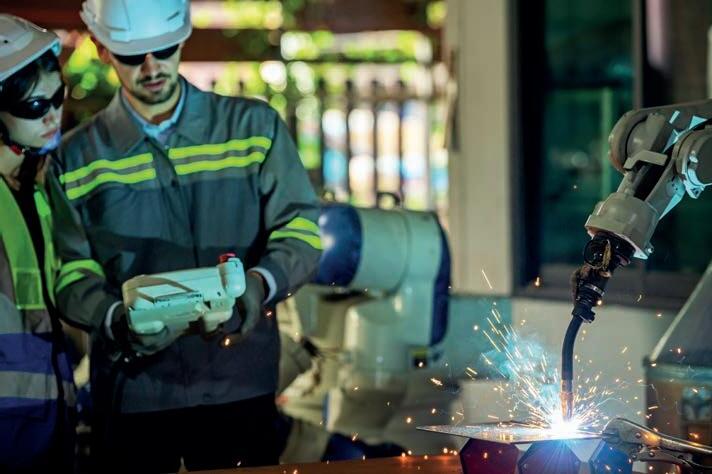
that occurred between 2008 to 2018, an average of 623,663 cases each year. This caused a 2.2 million full time equivalent (FTE) productivity loss between 2008 to 2018, and on top of this $37.6 billion in costs were incurred by the health system and $49.5 billion in employer overheads.
Fewer work-related injuries or illnesses would accelerate our transition to a knowledge-based economy, and create more higher-skilled, safer roles.
As automation reduces routine, dangerous manual work, workplace injuries are expected to drop by as much as 11 per cent. For instance, the use of robots and co-bots (particularly in confined spaces) helps to remove welders from immediate exposure to welding fumes, ultraviolent radiation, heat and sparks.
Greater job satisfaction
A move towards the use of Industry 4.0, robots and cobots will unburden the average Australian of two hours of the most tedious and manual work each week over the next ten years. Approximately 62 per cent of low-skilled workers will experience improved job satisfaction, and wages for non-automatable work will increase by around 20 per cent.
Introduction of cobots into production lines allow businesses to make better use of human skill and innovation, with machines taking over mundane tasks so that employees can focus on critical thinking, quality and creativity. This opens up new opportunities for businesses to improve and optimise their operations.
It can also result in other, more indirect, payoffs. For instance, using a plasma welding machine or a Microsoft HoloLens, or programming a cobot, can be more interesting than traditional MIG or TIG welding. Several Weld Australia members that have invested in advanced technology have reported marked improvements in recruiting, training and retaining staff long-term as a direct result.
Metal 3D printing or additive manufacturing

Metal 3D printing, also known as additive manufacturing, is a rapidly evolving technology that is revolutionising the manufacturing industry. This technology allows for the production of complex geometries using processes familiar to any welder, such as submerged arc welding,
TIG welding, and electrobeam welding. However, 3D printing goes beyond traditional welding by using a computercontrolled system to precisely deposit metal layer by layer, allowing for precise control over the final product.
Metal 3D printing enables the generation of on-the-go components for industries like defence and aerospace, or spare parts for assets like cranes and armoured vehicles. Businesses are able to create a digital inventory of parts rather than holding a physical inventory, eradicating overheads like storage and transport.
Metal 3D printing allows for rapid prototyping and the ability to produce custom, one-of-a-kind parts quickly and easily. It has led to the development of new materials and applications that are driving innovation in the industry. For example, metal 3D printing is being used to create lightweight parts for the aerospace industry, reducing fuel consumption and emissions.
Traditional manufacturing methods often result in a significant amount of waste material, while metal 3D printing allows for precise control over the amount of material used, reducing waste and material costs.
Weld Australia is in the process of establishing an Advanced Manufacturing Industry Group. This Group will facilitate technology transfer across the additive manufacturing industry, and share technical knowledge to enhance safety, manage risk, reduce cost, and optimise operating efficiency. Our Industry
groups also provide access to a unified peak industry body that can advocate to government on behalf of members.
How Weld Australia can help
Weld Australia can provide businesses with access to this highly specialised and cutting-edge technology. We have a thorough understanding of the concepts, design and process integration of automation and robotic solutions. Our team members are at the forefront of welding technology and techniques and are involved in ISO Standards Committees that oversee the standardisation of various technologies. For instance, Cornelis Van Niekerk, our Business Manager for Defence Welding, serves on two ISO Standards Committees: one for metal 3D printing and the other for friction stir welding. These Committees are focused on issues such as safety measures, implementation, and quality control.
If your fabrication business is keen to improve its productivity, profitability and working conditions for its employees, Weld Australia can help with feasibility studies, conceptualisation, integration of advanced technology and techniques, system verification and demonstration, project management, development of welding procedures and welder qualification.
If you need help or further information on any of the above, please contact Cornel is Van Niekerk (Business Manager - Defence Welding, Weld Australia) on c.vanniekerk@weldaustralia.com.au.
manmonthly.com.au Manufacturers’ Monthly JULY 2023 7
Embracing technology like 3D metal printing in the welding space can create a range of benefits for businesses.
Weld Australia is in the process of establishing an Advanced Manufacturing Industry Group.
Comment
CSIRO to assist automated system innovators with an enhanced development platform

DURING more than two decades with CSIRO I’ve witnessed and been part of numerous digital innovations across Australian manufacturing and other industries. In the majority of cases, I’d class these as being part of what is known as the third industrial revolution – computerisation. We are now in the midst of the fourth industrial revolution – Industry 4.0. Robotics and automation are central to Industry 4.0 and are major CSIRO R&D priorities because we’re both a voracious user and a cutting-edge developer of them. Globally and domestically the manufacturing industry is at a challenging point. Imperatives for companies, industries and countries include achieving net zero emissions, improving sustainability, and contributing to a circular economy. Robotics, autonomy and Artificial Intelligence (AI) are key for ongoing business competitiveness, and for establishing more sustainable manufacturing systems. Pertinent examples of robotics, autonomy and AI in the manufacturing and logistics context are autonomous ground or aerial vehicles, intelligent assistive cobotics, and AI-assisted machine and process controls. These can underpin step changes in competitive advantage. They are also complex innovations requiring dependable hardware and software components. I’m a strong advocate for using Robotics Operating System (ROS) as the software platform upon which to base many of these kinds of innovations.
What is ROS?
Some in the manufacturing industry will be familiar with ROS and its current version ROS2. ROS is a major open-source software initiative which emerged out of Stanford University in the USA during the mid-2000s. Additional to operating robotics and automation, ROS is a useful toolkit for complex sensing, computer vision, data fusion and real-time AI. ROS is applied in scientific, industrial, and aerospace domains.
ROS or ROS2 is not actually an operating system in the standard sense of computer operating systems such as
Windows or Linux. ROS is a software framework and suite of libraries used for controlling and coordinating robotics system elements. The software executes within a mainstream computer operating system on any device capable of running it, including cameras, robot arms and machine controllers, within a centralised, distributed and/or edge computing manner.
ROS2 is now the preeminent open-source option for programming robotics, automation and sensing. It is predicted that 55% of commercial robots shipped in 2024 will have at least one Robot Operating System package. (Source: ABI Research, 2019).
At CSIRO we have used ROS and ROS2 within autonomous vehicles, robots constructed from flexible materials, real-time distributed video streaming, and real time object recognition systems.
We have also used it in integrated laboratory robotics and sensing systems, additive manufacturing robotics control
and real-time sensing, and multicamera high precision measurement systems.
ROS2 can handle greater volumes of larger and/or more complex data in closer to real time compared to the MQTT-based systems that are popular for Industrial IoT (noting also that ROS2 can interoperate with MQTT, e.g., for ROS2 nodes to exchange MQTT messages with IoT sensors). ROS2 offers a non-proprietary and expanding development platform, efficient and effective solution creation, and longterm support from a large pool of international practitioners.
Taking on ROS2
In a manufacturing context, CSIRO is using ROS2 to integrate robot arms, cameras and scanners, additive manufacturing and machining tools, and computer vision and other AI. ROS2 enables us to manage chemical and materials laboratory automation,

process sensing and control, and the pre-commercial development of new robotic additive manufacturing work centres. We are also pursuing many other ROS2 applications within CSIRO in agriculture and other domains besides the manufacturing domain.
In our experience, and from what others have written, we know that understanding and using ROS2 can be challenging. This is especially the case for smaller teams using the platform for the first time. The learning curve can be very steep. Within CSIRO there are many ROS2 success stories but also many burned fingers from insufficient assistance in the initial stages of adopting ROS2.
Kick-starting a journey by contracting or hiring ROS2 developers is a great option. Accessible and professional sources of expertise and help around ROS2 are indeed available. However, few companies in Australia have been long-term adopters of ROS2, and experienced ROS2 engineers are now in great demand globally. The creates
8 JULY 2023 Manufacturers’ Monthly manmonthly.com.au
SIMON DUNSTALL – Principal Research Scientist, CSIRO Data61
The CSIRO will work closely with industry to develop automated systems.
a workforce undersupply issue, and I see this as having three critical dimensions.
Firstly, a lack of people with practical ROS2 knowledge leads to a continued reliance on proprietary, legacy, and out-of-date approaches to automation, sensing and robotics. This constrains Australia’s manufacturing innovation success in terms of technical performance, interoperability, and product longevity.

Secondly, it locks the available robotics software engineering labour force into a low productivity regime. The old ways require more intensive effort in developing and (especially) maintaining solutions. Moreover, they put out of reach the opportunity to freely leverage the vast global capacity which is directed at open platforms including ROS2.
Thirdly, the Australian robotics community is probably too small to properly support unduly divergent and proprietary approaches to robotics. Australia needs workforce mobility between projects, products, and employers. Similarity and familiarity of solutions that are developed across the manufacturing sector and the Australian innovation system is also required. We need to be able to concentrate our education and upskilling effort.
It expected that some elements of these dimensions will be addressed or dissipate in future. For now, for a practical ROS2 journey, this puts the emphasis back onto developer communities and selfeducation approaches.
The global online developer community is a great asset for any development team, but not sufficient to ensure initial or ongoing success. Vibrant geographic and sector-specific communities are crucial. Resources such as do-it-yourself ROS2 project kits, designed to deliver early wins, are also required.
To the best of my knowledge, a community for ROS2 in Australia mainly exists among R&D institutions. A broad and national ROS2 community is only nascent in Australian advanced manufacturing. I know of many advanced manufacturing robotics and machine developers, Industrial IoT product innovators, and system integrators in Australia who are aware of ROS2. The majority however are presently deferring ROS2 adoption for want of stronger innovation support and better entry points that assure success.
The ROSella initiative
CSIRO is seeking to play its part in turning this around via an initiative that we have named ROSella. Initially incubated inside CSIRO as a stepchange in how we approach robotics and automation development, we are launching ROSella nationally in the second half of 2023. ROSella is intended as an open national community around ROS2 with a strong advanced manufacturing applications focus.
Curating and maintaining a subset of ROS2 and other software modules that interoperate and address major use cases in manufacturing is a key plank of ROSella. In our experience, ROS or ROS2 can become difficult to get up and running when third party software (proprietary or open) is needing to be integrated with it. Getting Windows deployments of ROS2 to work has also been troublesome on occasion. Commercial developers in particular need confidence that teething troubles and core platform interoperability is assured, hence ROSella’s focus is on a core ROS2 subset.
Easing the adoption barrier is helped by the availability of hardware and software starter kits that get ROS2
working out-of-the-box. These are demonstrators, confidence builders, and seeds for more complex systems. At CSIRO we have developed a low-cost computation box and camera kit that allows a ROS2 demonstrator to be built and operated by “newbies” in a single afternoon. Several such units are being made available across our organisation for hire by R&D teams beginning ROS2 journeys. Extending this service to others in the innovation system is part of ROSella’s brief.
To be part of a ROS2 system, each intelligent device in the system needs to implement a ROS2 software interface, which is only sometimes natively implemented out-of-the-box. Furthermore, the international ROS2 community can lag in developing ROS2 software interfaces for newly released devices, most notably for cameras of various kinds. In-silico device representations are also necessary for simulating systems (e.g., in ROS’ own Gazebo simulator) prior to building them and this extends the interface development effort. CSIRO is equipping the ROSella community with tools and resources to speed up the device interface and in-silico
emulator development process.
ROSella is also a channel for advanced IP developments out of CSIRO and elsewhere to reach mainstream robotics, automation and sensing applications. Key present examples are in new methods for multi camera system calibration and control, and in enabling real-time video streaming and object-detection AI through coupling ROS2 with the popular GStreamer libraries.
Nucleating an energised and distinctly Australian innovation community around ROS2 is another major aim of ROSella. We have learned from experience and observation that community building is not a simple task. Facilitating the open exchange of ideas and value, at selfsustaining scale, takes careful curation and significant resourcing. For ROSella this will come in part through the activities like the ROS2 starter kits. It will also need incumbent ROS2 devotees, including CSIRO, to come together and co-invest the time, money and energy that is needed to support Australia’s ROS2 adoption.
If this collaborative approach speaks to your business, then contact Simon Dunstall or Christian Ruberg on 1300 363 400, or email fdmf@csiro.au
manmonthly.com.au Manufacturers’ Monthly JULY 2023 9
Having recognised a number of challenges, the CSIRO has implemented the ROSella program to help industry.
Comment
TIM ODOKEYCHUK – President,

People-centric leadership: Unlocking your continuous improvement culture
AS many of those reading know, developing a mature culture of Continuous Improvement (CI) is a journey which some may feel is one they have been on for a lifetime.
Those who have well established CI systems will have likely developed a daily management system – integrating their work with improvement for employees, leaders and in turn specialised support resources ensuring stable processes, allowing a team to acheive sustained performance.
Many of those businesses would have performance metrics that are timely and meaningful, with clear targets aligned with business plans and strategies to deliver success.
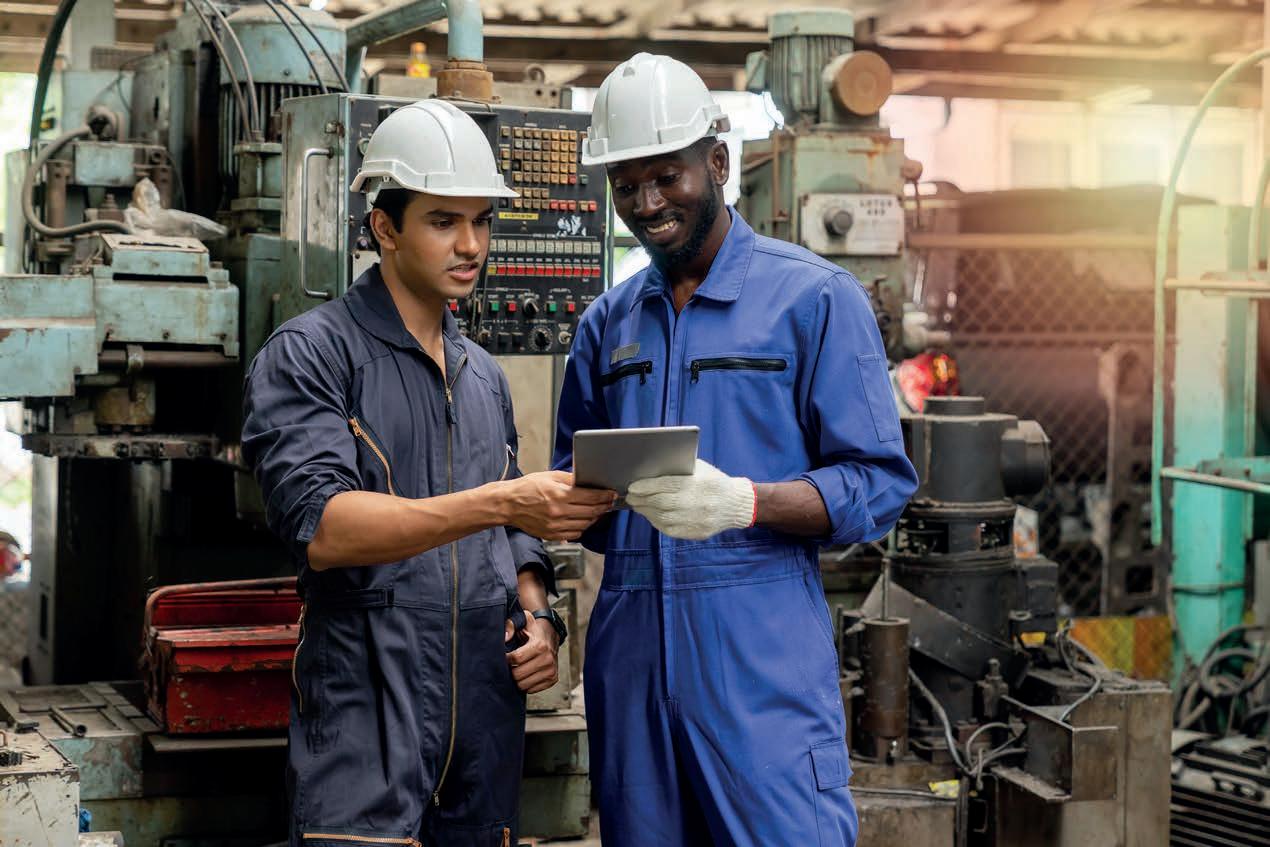
They go about exception-based or observational reviews to uncover opportunities for improvement, while employees use systematic methods of root cause analysis and problem-solving to address challenges.
Perhaps in less mature environments, there are only a few key people that can describe what is happening in a process and whether it’s meeting the needs of the customer. Management launches into erratic bursts of effort to ‘figure out’ what just happened and why the owner, customer or other department is unhappy with recent work.
There are likely issues related to turnover of people, less standardisation in the systems and generational loss of knowledge during staffing changes.
It can be uderestimated the role that leaders play in the systems described above.
Many leaders will deliver a basic awareness in continual improvement to their teams and expect them to simply take the idea on board.
This give and watch approach is like providing our team a car and asking them to drive it while we sit in the grandstand. The team is bound to fall short of the
desired results, regardless of the good intent.
Instead, an organisation who is truly wishing to strive for excellence must ensure their leaders practice, live and learn alongside their teams. They should be close enough to the process to feel the strength or fray within and to know where to hem, patch or tailor the next curve.
Achieving a bond is a matter of trust and confidence that the journey is on a shared pathway. At the heart of this journey lies respect for people.
Respect for people: connected cooperation
We hear the term respect for people often in our CI journeys. It often shows up in the ‘values statement’ of organisations – but what does it really mean?
Does it mean that everyone’s getting along and that there’s no conflict in
the team? Does it mean that everyone gets a bonus if we meet our targets?
Does it mean that we celebrate work anniversaries and birthdays at monthly updates? It’s likely a little more than this.
Perhaps respect for people means that employees understand the organisation’s direction and their role in contributing to its goals.
Individuals are well-informed, capable, fulfilled, and self-reliant, bringing out their best for the the team.
Most likely they are valued for their skills, knowledge, and experience, and have autonomy to make decisions and implement simple improvements.
Differences aren’t seen as defects but instead perspectives to leverage and opportunities to support each other along the way.
Ultimately, the team embraces a culture of experimentation and learning from practice and failure, where together they have the ability to challenge ideas
10 JULY 2023 Manufacturers’ Monthly manmonthly.com.au
People-centric leadership sets a positive tone for the whole organisation.
AME Australia
and policies for the sake of improvement towards common goals.
In my experience, the above is not always the starting point however, achieving an underlying state of respect for people is the ‘grease between the gears’ that allows the methods, tools and continuous improvement thinking to thrive.
Over time, this state creates highly effective teams that can overcome great barriers, who reject negativity, dishonesty and defeatism all the while learning and building their capability, solving more and more complex problems together.
This connected cooperation sounds good, doesn’t it? So why isn’t it the norm in our industry?
The importance of people centric leadership:
Leadership sets the tone for the entire organisation.
Through action or inaction, directive or suggestion, by praise or by punishment – ripples in the pond can become the behavioural waves that
come back from the other shore to make changes to an organisation for the better.
At the root of things, employees who feel valued and empowered are more likely to contribute their best ideas, proactively identify improvement opportunities, and embrace change, fuelling the organisation’s growth and success.
This type of respect is needed as a constant from leaders within an organisation. When continual improvement efforts move from being an initiative; to a shared a way forward; then ultimately a culture through repetition and resilience that protects the underlying thinking and values of the group.
This can stem from a people centric leadership approach which recognises that employees are the foundation of continuous improvement.
Those practicing people centric leadership involve employees in decision-making processes, encourage collaboration, and provide opportunities for growth and development both
one-on-one and in group development sessions.
They do so systematically but responsively in a way that’s understood and transparent - think ‘leader standard work’ which is highly proportioned to being where the work is happening and coaching with on-the-job learning where a shared perspective is created and mutual trust is rooted.
Through this approach, leaders can create an environment where individuals feel valued, motivated, and empowered to contribute their best. They also become better advocates for investment and system level change needed across the organisation to improve operating conditions and effectiveness of the work being done.
Unfortunately, traditional management creates the opposite effect.
Whether intended or not, a less people-centric approach stifles the potential of continuous improvement by disempowering employees and inhibiting their creativity.
Be on the lookout if decisions are typically made at the top and cascaded
downward without meaningful involvement or input from the workforce.

This hierarchical approach often leads to a lack of ownership and resistance to change where it’s need most as no preparation or context of how this helps them secure longer-term opportunities for themselves, their families and their colleagues has proceeded the proclamation that from tomorrow we’re going to follow “a new way”.

Perhaps this contributes to how often we hear that someone has left their boss, not the company? As manufacturing leaders, I’m sure we all know which type of leader we’d rather be.
We should therefore do everything in our power to enable, not hamper our organisation’s ability to become better today than it was yesterday.
If we want to truly excel, we need to ensure we nurture and support one of the greatest appreciating assets in our company – our people, and only through building the mutual respect that comes from weathering storms and climbing hills together, would we truly have earned the privilege to lead others.
Sydney
Olympic Park Wednesday 20 - Thursday 21 September 2023 whsshow.com.au SCAN TO REGISTER FREE manmonthly.com.au Manufacturers’ Monthly JULY 2023 11
Showground
Comment
Northern Territory leads the way
MANUFACTURERS’ Monthly sat down with managing director of the Advanced Manufacturing Growth Centre (AMGC) Dr Jens Goennemann to break down the Northern Territory’s Advanced Manufacturing Ecosystem Fund and this year’s federal budget.
The budget announced in May was the first-full Labor budget handed down in 10 years and it will see a widening of support provided to small to medium sized manufacturers according to AMGC.
Through matched-funding and mentorship, Australia’s new Industry Growth Program has the potential to expand the pipeline of investment-ready projects for the $15 billion National Reconstruction Fund to consider in coming years.
Through loans, guarantees and equity investments, the National Reconstruction Fund will partner with the private
sector to invest in priority areas that leverage Australia’s natural advantages and strategic priorities in renewables and low emissions technologies, medical science, transport, value add in agriculture, forestry, and fisheries, value add in resources, defence capability and enabling capabilities.
Utilising Australia’s natural resources for the manufacturing industry is something that Goennemann believes can make Australia competitive on a global scale.


“I will encourage every Australian government, past, present or future to focus on areas of strength that we have or areas of strength that we want to have,” Goennemann said.
“We have one of the strongest health systems and that came from choices made by government, they should be utilising a similar framework for the country’s manufacturing capabilities.”
Goennemann states that as an
industry, manufacturing should look to leverage the abundance of natural resources available to grow itself.
AMGC has identified and advocated for a need to support small businesses as they enter the Industry Growth Program and later the National Reconstruction Fund to prepare them for success.
“The projects announced in this budget will take time to deliver,” Goennemann noted.
“For this budget to see a reallocation of funds, for example, from the Entrepreneurs’ Programme to an Industry Growth Program, gives the government the opportunity to curate companies to be investment ready including but not limited to manufacturers for them later to be picked up by the National Reconstruction Fund.
“The National Reconstruction Fund, just by sheer size of its organisation will struggle to reach SMEs. We believe the IGP
offers an opportunity to get manufacturers investment ready and absorb the larger funds that will flow from the NRF, how that will look remains to be seen but I anticipate AMGC could play a role in helping to maximise the impact of the program,” Goennemann explained.
“The realities of the industry structure in Australia are that we have 47,000 manufacturers and around 90 per cent employ less than 20 people. It will take time for them to be ready to take a cheque from the National Reconstruction Fund and we already support some that may.”
In September 2021, the Northern Territory Government partnered with the AMGC to launch a $7.5 million Advanced Manufacturing Ecosystem Fund (AMEF), in response to local manufacturing successes in the Territory.
The Fund delivers on the recommendations from the Territory Economic Reconstruction Report and

12 JULY 2023 Manufacturers’ Monthly manmonthly.com.au
The AMGC believes what is happening in the NT is a shining example for the rest of the country.
DR JENS GOENNEMANN – Managing director, Advanced Manufacturing Growth Centre (AMGC)
successfully increasing Australia’s manufacturing capability. With a focus on expanding manufacturing in the Northern Territory, co-investments will target local projects that seek to: grow an advanced manufacturing ecosystem and capability in the Northern Territory across the Territory’s priority sectors; and increase investment in advanced manufacturing activity in the Northern Territory, and secure a greater number of advanced manufacturing jobs located in the NT.
commercialise new products and processes, including transitioning a new product or process from pilot/ prototype stage to full commercial operations; and/or
support early-stage small scale and pilot research projects in advanced
more quickly move to larger-scale commercialisation.
Goennemann spoke to the importance of this fund and said that it is important to the Northern Territory and is a shining example for the nation as a whole.
“The Northern Territory is the first sub-national jurisdiction that came on board and worked with AMGC together in the advanced manufacturing ecosystem function,” Goennemann said.


“We jointly curate the ecosystem of manufacturing capability and help Northern Territory manufacturers to advance. Eventually we hope to advance, grow and allow manufacturers to be investment ready for an uptake of NRF or other sources of capital.
While it is important for us to have national funds which flow through seven key areas, each jurisdiction has its own unique strengths. For example,
capabilities, there is only so much you can do at a national level so focusing in at a sub-national level is imperative.
“That is what the Northern Territory leaned in on heavily – how we can supplement what’s being done on a federal level and really help local projects to succeed and tackle local challenges,” Goennemann added.
Funding for the AMEF ranges from $25,000 up to $500,000 (or more based on scale and impact), but must be equally matched by industry in cash.
AMGC’s Perceptions of Australian Manufacturing Report has evidenced that Territorians support for, and knowledge of, manufacturing is the highest of anywhere in mainland Australia, rising by 33 per cent, to 83 per cent over the pre-pandemic survey.
Dr Goennemann explained that the fund in the Northern Territory is not a test of its capability but in fact an example
level can reap rewards
“We are way beyond the testing stage of this, we are mid-program. It’s [AMEF] an example which has worked on the federal level, it’s an example which works on a sub-national level, and it is an example which works in other countries who have a deliberate industry policy to develop this strength and not leave it up to market forces alone,” he said.
“The important part for us is making sure that manufacturing in the Northern Territory does not just consist of what happens in Darwin but includes places like Alice Springs and Katherine. Our projects happen everywhere in Australia, not just in our big five cities. By expanding where manufacturing occurs it boosts communities resilience, competitive jobs, helping manufacturers get a leg up helps communities get a leg up – it means we can all grow together.”
manmonthly.com.au Manufacturers’ Monthly JULY 2023 13
It is an exciting period for the AMGC as they work with manufacturers across the country.
Combat systems agreement boosts sovereign shipbuilding capability
BAE Systems, Lockheed Martin, Saab, and the Department of Defence have signed a new agreement to integrate the Navy’s existing guided missile destroyers and Hunter class frigates in Australia.
The Combat System Integration (CSI) Collaboration Agreement (CCA) will grow a long-term, cost-effective and agile CSI sovereign industrial capability for the Navy’s major surface combatants.
The agreement is another significant step towards the development of continuous naval shipbuilding in Australia.
Specifically, the collaborative relationship will support CSI in surface vessels fitted with the US Navy’s Aegis combat management system – produced by Lockheed Martin and with an Australian Interface developed by Saab Australia.
Through the CCA, BAE Systems
Australia, Lockheed Martin Australia, Saab Australia and Defence have established the Combat System Integration – Integrated Project Team (CSI-IPT).
The CSI-IPT team will comprise professionals from the Department of Defence and an equal mix of combat systems integration professionals from each of the industry organisations, facilitating a ‘one team’ approach.
As part of the CSI-IPT, all four organisations will work collaboratively as a united combat systems team to design, integrate, test and deliver the integrated combat system for the Hunter class frigates and the major combat systems upgrade to the Hobart class destroyers.
Managing director of BAE Systems Australia – Maritime, Craig Lockhart, said, “Key to delivering the high-end warfighting capabilities for Australia’s
naval surface fleet is the design, installation and integration of the combat management systems into a warship, and that’s why we worked so hard to secure this collaborative arrangement with Defence, Lockheed Martin Australia and Saab Australia.
“Through close collaboration, we will establish an enduring Combat Systems Integration sovereign industrial capability for our nation.”
Vice president of operations Lockheed Martin RMS Australia and New Zealand, Steve Froelich, said, “As the manufacturer of Aegis, the world’s most advanced combat system, Lockheed Martin Australia is proud to integrate, deliver and sustain this key maritime capability that safeguards our nation together with our valued partners –Defence, BAE Systems and Saab Australia.
“Working together makes us stronger.
The CCA aligns all four organisations on a joint path of success to ensure Australia’s security, economic growth and ongoing military interoperability with the US and allied partners across the Indo-Pacific.”
Managing director, Saab Australia, Andy Keough CSC said, “Saab looks forward to working with our collaboration partners to build on the decades of combat system integration work we have successfully performed in partnership with the Department of Defence,” Keough said.
“Through this collaborative partnership, and as the nation’s sovereign combat management system provider for the Royal Australian Navy’s Surface Fleet, we are strengthening Australia’s sovereign defence capability and jointly developing the skilled workforce we need to deliver future programs.”

News @MM 14 JULY 2023 Manufacturers’ Monthly manmonthly.com.au
This announcement will see Australia improving its shipbuilding processes.
News @MM
New innovation centre to advance transport technology
Victorian minister for small business Natalie Suleyman officially opened Directed Technologies’ $1.5 million Connected Mobility Innovation Centre for smart technology in fleet vehicles.
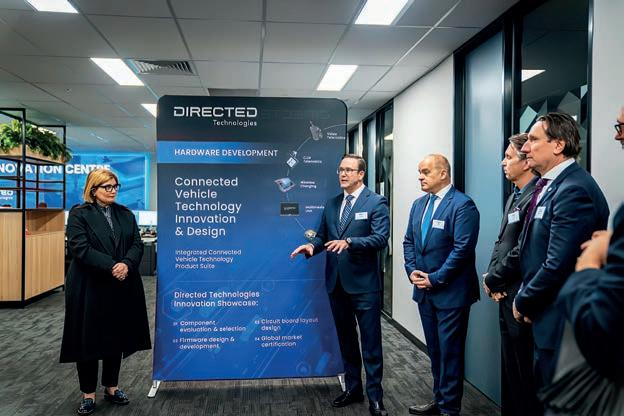
The centre, which is located within Directed Technologies’ new $15 million headquarters in Tullamarine, is expected to create nearly 60 new jobs over three years and allow the company to expand its export markets
Directed Technologies designs and manufactures navigational systems for the transport industry and fleet vehicles such as freight and emergency services trucks.
The company’s system considers a vehicle’s dimensions, weight and clearance when planning routes to help its driver travel safely and efficiently to their destination.

The new centre will enable Directed Technologies to expand its transport technology by developing smart sensors that can keep track of important safety
metrics including driver fatigue, tyre pressure and temperature of refrigerated cargo.
This means clients such as Australia Post can know exactly what is happening to their vehicles on the ground, improving safety and service reliability.
Victoria’s manufacturing sector is one of the state’s largest employers, contributing around $31 billion to the economy each year and providing around 30 per cent of Australia’s manufacturing output. Manufacturing also supports small businesses and local jobs in their supply chains.

The Victorian state government’s Made in Victoria 2030: Manufacturing Statement outlines its vision and actions to ensure Victoria continues to be a place for advanced manufacturers to grow and thrive, including in key sectors such as digital and advanced technologies.
“We support businesses like Directed Technologies because they bring skilled jobs and investment to Victoria, which
further cements our status as the nation’s advanced manufacturing hub,” Suleyman said.
“Our advanced manufacturing industry supports many small businesses along their supply chain – boosting the economy and creating local jobs.”
Directed Technologies executive director Brent Stafford said, “We’ve built a world-class facility right here in Victoria
thanks to the assistance of the Victorian Government and developed innovative solutions for the world’s biggest transport companies that have allowed us to compete against global competitors –and win.”
Member for Sunbury Josh Bull said investing in innovation today will increase Victoria’s competitiveness and help create the industries and jobs of the future.
manmonthly.com.au Manufacturers’ Monthly JULY 2023 15
The new facility should create close to 60 jobs.
News @MM
QLD green jet fuel industry set to soar with Qantas partnership
The Queensland State Government has signed an MoU with airline giant Qantas to unlock the state’s potential to manufacture sustainable aviation fuel (SAF) locally.
The partnership will include exploring how to fully leverage sugarcane and agricultural by-products for biofuel production and the potential for developing new feedstock sources and processes.
More broadly, the parties will focus on developing a Queensland-based SAF supply chain.
SAF is yet to be manufactured in Australia at a commercial scale.
Qantas currently uses green aviation fuel sourced overseas and is targeting 10 per cent SAF in its fuel mix by 2030, and about 60 per cent by 2050.

The announcement, made during Australian Renewable Fuels Week, is the latest in a series of SAF wins for Queensland.
In March this year, the State Government, Qantas and Airbus
announced support for Jet Zero Australia to commence a feasibility study for a new biorefinery in Queensland, which could produce up to 100 million litres of SAF a year.
The State Government has also partnered with Ampol and ENEOS, which will assess the feasibility of delivering an advanced biofuels manufacturing plant at Ampol’s Lytton site.
Oceania Biofuels also plans to build a commercial aviation fuel biorefinery in Gladstone, which could generate up to 350 million litres of SAF and renewable diesel each year.
“When it comes to decarbonising our skies, Queensland is the place to invest,” said deputy premier Steven Miles.
“Growing our SAF industry is one of those opportunities that will fuel Queensland’s economic future and contribute to decarbonisation targets.
“With our rich supply of feedstock and skilled workforce, Qantas, and the world, has recognised Queensland
as an ideal location to establish an Australasian SAF supply chain.”
“Partnerships like this one with Qantas, position Queensland as a SAF hub, along with the right mix of investment, government support and policy, and industry collaboration,” he added.
“Importantly, growing industries that will be in demand in a decarbonising world will create more good jobs for Queenslanders and new export opportunities.”
Qantas Group chief sustainability officer Andrew Parker said, “Air travel is a critical industry, especially in a state as big as Queensland with an economy that benefits so much from tourism. Having a clear plan to decarbonise air travel so we can keep connecting Queensland and Australia in the decades ahead is key for the future.
“Sustainable fuels are the most significant tool airlines currently have to reduce their emissions, particularly given they can be used in today’s engines
and fuel delivery infrastructure with no modifications.
“Qantas will be the largest single customer for Australian-made SAF, so it’s fantastic that the Queensland Government is seeking to partner with us so we can work together on establishing the industry from the ground up.” Queensland produces significant feedstock needed to make SAF, including tallow, sugarcane waste pulp, cereal cropping residues and pongamia.
SAF can be used in existing aircraft engines and airport refuelling infrastructure to cut carbon emissions typically by up to 80 per cent on a life cycle basis.
An Australian SAF industry could be worth $3 billion annually by 2030 and could create up to 15,600 jobs – mostly in regional areas – nationwide by 2050.
The new partnership with Qantas is further progress towards growing a local SAF industry under the Queensland Biofutures 10-Year Roadmap and Action Plan.
16 JULY 2023 Manufacturers’ Monthly manmonthly.com.au
The partnership is a step forward in sustainable aviation fuel manufactruring ability in Australia.
@MM
New Melbourne centre to advance manufacturing training
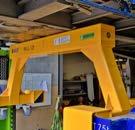

Minister for Training and Skills and Higher Education Gayle Tierney officially opened a new $3.2 million Advanced Manufacturing Centre of Excellence at Melbourne Polytechnic’s Heidelberg campus.
The new centre will train Victoria’s next generation of engineers to enter the workforce equipped with the skills and knowledge that will keep students at the forefront of the advanced manufacturing market.
The latest industry-grade technology in robotics, 3D printing, and computer design will support a range of industries including biomedical, defence and aerospace and food technologies.
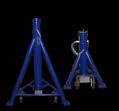
In partnership with Apprenticeships Victoria, the new centre will promote engineering career opportunities to secondary students and boost hands-on training for entry-level engineers across the state.
The Victorian state government has invested $1.4 million in the project
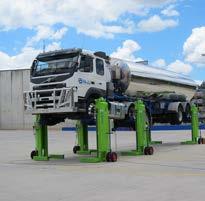
through Apprenticeships Victoria.
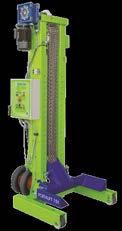
Manufacturing employs more than 261, 000 people and contributes almost $31 billion to the state’s economy each year. This centre will help address an

industry need for more engineering tradespeople identified in the Victorian Skills Plan.

Free TAFE has saved students around $340 million in tuition fees since the
state government introduced it in 2019 – removing the barriers to training for a great new career for around 137,000 students – according to a government media release.

Since 2014, the government has made a record $3.5 billion investment to rebuild TAFE and support higher education to ensure Victorians have access to high quality education and rewarding career pathways.
“We’re making sure Victorians can go to their local TAFE and get a great qualification for our state’s most indemand jobs,” Tierney said.
“This centre is just one of the ways we are ensuring that we have the highly skilled, sustainable workforce needed to secure Victoria’s future prosperity.”
Member for Ivanhoe, Anthony Carbines, said, “We’re investing locally so that every student has the skills and high-quality training they need to power our future.”
PA RT OF THE GROUP News
manmonthly.com.au Manufacturers’ Monthly JULY 2023 17
The new centre will support the biomedical defence and aerospace and food technologies
News @MM
PM Albanese launches new rocket at Gilmour Space Technologies
Gilmour Space Technologies welcomed prime minister Anthony Albanese to its Gold Coast factory to formally unveil and ‘launch’ the Eris rocket – Australia’s first home-grown orbital launch vehicle.
“This is a great Australian success story. A company that began eight years ago but now employs 200 people here at the cutting edge of innovation, science, new technologies, and new jobs,” said the prime minister as he toured Gilmour Space’s sovereign manufacturing facility, and started a new tradition of signing Australian rockets before launch.
“You’re looking at the first Australianmade rocket that will attempt orbital space launch. Their hybrid rocket engine
technology is one of the first in the word to use a combination of solid and liquid propellants.

“When this rocket goes into space, it will carry 300 companies with it. Australia will become the 12th country in the world to be able to have access to this technology – designed, manufactured and built right here (on the Gold Coast) and creating high quality jobs.”
“This is one of the companies that we’re looking at when we have our National Reconstruction Fund and that whole agenda about a future here made in Australia – making use of an Australian procurement policy to buy Australian and making sure we back Australian
science and innovation,” Albanese added.
“Australia can compete with the rest of the world,” he said.
“What we need to do is to back our businesses that are doing it. This is truly an Australian manufacturing success story, and we want more of them.”
Adam Gilmour, CEO of Gilmour Space, said, “We are proud to have the Prime Minister come see our Australian-made orbital rocket and space manufacturing facility.
“Australia must have its own sovereign launch and satellite technologies if we are serious about growing our capabilities in defence, communications, and advanced
manufacturing. Gilmour Space is at the leading edge of these technologies.
“Both the State and Federal governments have been great supporters of the space industry here in Queensland, and we appreciate their ongoing support for Australian innovation, high-tech jobs, and manufacturing.
“The team is working hard toward the first test launch of our Eris rocket later this year from the Bowen Orbital Spaceport in north Queensland. Only 11 nations have launched their own rockets into orbit, and our efforts will help to build a significant dual-use capability for Australia.”
18 JULY 2023 Manufacturers’ Monthly manmonthly.com.au
Gilmour Space Technologies will launch the first orbital space rocket from Australia.
Mars Petcare invests $112.6 million to bolster regional capabilities
Construction of the new facility at the Wodonga factory has commenced and is set to be fully operational by mid 2025.
Supported by Regional Development Victoria, Mars Petcare has announced a significant investment in its Wodonga factory to expand its pet food manufacturing capabilities and create more than 60 new jobs in regional Victoria.
Leading pet food manufacturer Mars Petcare Australia has announced it will be investing $112.6 million to expand pet food manufacturing capabilities at its Wodonga factory.
Proud to have been manufacturing at the site since 1967, this project builds on more than $55.8 million invested at the Victorian facility over the past five years and will enable the company to future-proof its local operations for years to come by creating over 60 new jobs through the on-shoring of pet food production.
The investment will support the development of a 7,800sqm manufacturing facility dedicated to the production of single serve pouches, including two additional lines with a combined yearly capacity of 25kT – around 290 million pouches of cat food initially.
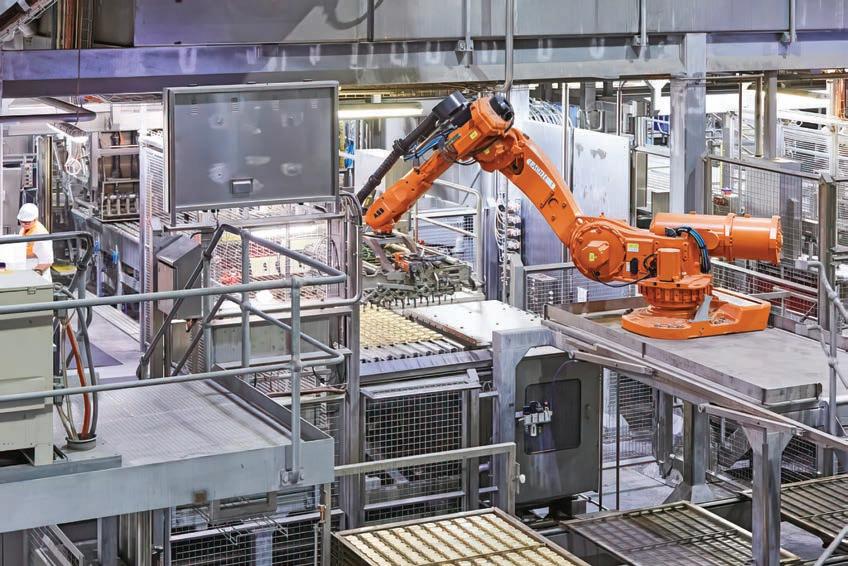
The new facility will primarily serve the Australian and New Zealand markets and the growth of both existing and new product ranges across the company’s well-known Whiskas, Advance, Optimum, and Dine brands.
Craig Sargeant, general manager at Mars Petcare Australia, spoke about the announcement.
“As a market leader, we are committed to bolstering our local operations by sourcing and making most of our portfolio right here in Australia. This significant investment will allow us to respond to pet trends including the continued rise in cat ownership – growing at nearly 4 per cent per year – more than twice as fast as our dog population,” he said.
“We’re also seeing increased demand for convenience, with pouch products representing half of the Australian wet cat food market and growing at nearly 10 per cent per year.”
As a result of the project’s contribution to the local economy, Mars Petcare Australia’s investment has been supported with grant funding from the Victorian government’s Regional Development Victoria.
Harriet Shing, Minister
for
Regional
Development Victoria, celebrated the announcement.
“As pet ownership continues to increase there are enormous opportunities for businesses like Mars to expand. We’re continuing to work
Visy completes major upgrade to Gibson Island recycling centre
Australian recycling giant Visy unveiled a $48 million upgrade to its recycling and remanufacturing campus on Gibson Island with Queensland premier Annastacia Palaszczuk and deputy premier Steven Miles.
The upgrade is part of Visy executive chairman Anthony Pratt’s commitment to invest $2 billion over the next decade – $700 million of that in Queensland – to reduce landfill, cut emissions and create thousands of green-collar Australian manufacturing jobs.
“This is a very proud day for our company because we’re not only manufacturers, we’re actually in the landfill avoidance business which is good for greenhouse gas reduction as
well because as things decay in the landfill they produce methane gas which is 84 times worse for climate change than carbon dioxide,” said Pratt.
“So recycling is an important weapon against climate change.”
The project will divert up to 39,000 tonnes of material from landfill – covering the equivalent of approximately 2,500 Suncorp stadiums – using a new state-ofthe-art paper optical sorting plant.
Instead of going to landfill, Visy will recycle and remanufacture this kerbside waste from hundreds of thousands of Queensland homes into 100 per cent recycled paper and corrugated boxes for the state’s farmers, and iconic food and beverage companies.
The upgrade was made possible thanks to co-investment support from the Queensland Government and is set to reduce landfill by up to 20kg per Queensland household annually.
The 100 per cent recycled paper will then be sent to Visy’s corrugated box plants, including the new one at Hemmant.
“We are transforming Australia’s recycling and manufacturing sectors through these initiatives,” said Pratt.
Pratt also praised premier Palaszczuk and her Government “for their foresight and dedication to practical environmental reforms.”
“You, premier and Deputy premier Miles, are champions of Queensland
with rural and regional producers to support investment in growth industries, to cement Mars Petcare’s long-term operations and workforce in Wodonga and its place in a strong market.”
manufacturing and under your leadership, Queensland has become an economic powerhouse” he said.
The Gibson Island project created hundreds of jobs during construction and has established even more green-collar manufacturing jobs on site.
Visy operates in more than 140 sites throughout Australasia and has trading offices across Asia and Europe. With over 7,000 employees, the company‘s innovative approach provides endto-end solutions for customer needs across paper, primary packaging, fibre packaging, packaging supplies and consumables, point of sale displays, automation, materials handling, logistics and recycling.
News @MM
manmonthly.com.au Manufacturers’ Monthly JULY 2023 19
Mars Petcare will add 60 jobs to its facility in Wodonga.
News @MM
New Bushmasters for the Australian Defence Force
The Australian Government has signed a $160 million contract with Thales Australia to deliver an additional 78 Bushmaster protected mobility vehicles for the Australian Defence Force.
The contract for the new Bushmasters was signed at Thales Australia’s Bendigo facility in the presence of member for Bendigo Lisa Chesters. The Bushmasters will continue to be manufactured in Bendigo, Victoria, with the first delivery expected in 2024.
Bushmasters are integral to Australia’s military capabilities – supporting security and stabilisation activities, including humanitarian assistance and disaster relief, both at home and abroad.
The Bushmaster is world-renowned for
innovative design features which protect its crew and passengers from landmines and other explosive devices, and small arms fire.
Minister for Defence Industry, Pat Conroy said, “I am delighted to be in Bendigo to announce this $160 million investment in regional Australia, securing more than 200 local defence industry jobs for the city.
“The iconic Bushmaster vehicle is supporting defence industry jobs in Australia, as well as saving lives in military operations around the world.

“The workforce at Thales Australia should be proud of the important contribution they make to providing a world-class capability for our soldiers
and to strengthening Australia’s national security.”
Thales Australia CEO Jeff Connolly said the manufacture of new Bushmasters would directly support jobs at the Bendigo facility.
“This is a strategic industrial capability that is vital for the Australian Defence Force. Today’s contract signing is an important expression of support from the Government, not just for the Bushmaster vehicle, but also for the manufacturing capability and Australian supply chain that produces and sustains the vehicles.
“Work will begin immediately on the new vehicles, with a mix of troop-carrying vehicles and Command vehicles to be manufactured over the next 18 months.
“More than 1200 Bushmasters have
already been manufactured at our Bendigo facility and as well as proving to be a lifesaving vehicle for the Australian Army in operations in the Middle East, they have been exported to eight nations including the Netherlands, UK, Fiji, Jamaica, New Zealand, Japan and Indonesia.
“Bushmasters gifted to Ukraine by the Australian Government are currently in service in Ukraine and providing a vital capability to the Ukrainian Armed Forces as they fight the illegal Russian invasion.
“In addition to our direct employment on site in Bendigo, the manufacture of Protected Vehicles supports around 360 jobs in our Australian supply chain with many suppliers across regional areas of Victoria and New South Wales.”
20 JULY 2023 Manufacturers’ Monthly manmonthly.com.au
Bushmasters are important to Australia’s military capabilities.
New ‘designer’ titanium alloys made using 3D printing
A team of RMIT and University of Sydney researchers have created a new class of titanium alloys that are strong and not brittle under tension, by integrating alloy and 3D-printing process designs.
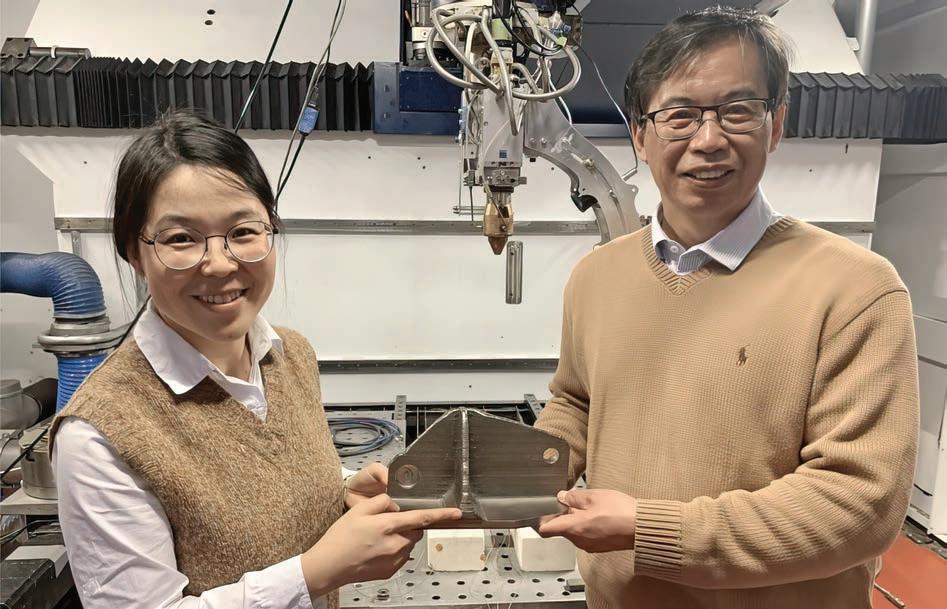
The breakthrough, published in the top journal Nature, could help extend the applications of titanium alloys, improve sustainability and drive innovative alloy design.
Their discovery holds promise for a new class of more sustainable high-performance titanium alloys for applications in aerospace, biomedical, chemical engineering, space and energy technologies.
RMIT University and the University of Sydney led the innovation, in collaboration with Hong Kong Polytechnic University and the company Hexagon Manufacturing Intelligence in Melbourne.
Lead researcher Distinguished Professor Ma Qian from RMIT said the team embedded circular economy thinking in their design, creating great promise for producing their new titanium alloys from industrial waste and low-grade materials.
“Reusing waste and low-quality materials has the potential to add economic value and reduce the high carbon footprint of the titanium industry,” said Qian from RMIT’s Centre for Additive Manufacturing in the School of Engineering.
What type of titanium alloys has the team made?
The team’s titanium alloys consist of a mixture of two forms of titanium crystals, called alpha-titanium phase and betatitanium phase, each corresponding to a specific arrangement of atoms.
This class of alloys has been the backbone of the titanium industry. Since 1954, these alloys have been produced primarily by adding aluminum and vanadium to titanium.
The research team investigated the use of oxygen and iron – two of the most powerful stabilisers and strengtheners of alpha- and beta-titanium phases – which are abundant and inexpensive.
Two challenges have hindered the development of strong and ductile alphabeta titanium-oxygen-iron alloys through the conventional manufacturing processes, Qian said.
“One challenge is that oxygen –described colloquially as ‘the kryptonite to
titanium’ – can make titanium brittle, and the other is that adding iron could lead to serious defects in the form of large patches of beta-titanium.”
The team used Laser Directed Energy Deposition (L-DED), a 3D printing process suitable for making large, complex parts, to print their alloys from metal powder.
“A key enabler for us was the combination of our alloy design concepts with 3D-printing process design, which has identified a range of alloys that are strong, ductile and easy to print,” Qian said.
The attractive properties of these new alloys that can rival those of commercial alloys are attributed to their microstructure, the team says.
“This research delivers a new titanium alloy system capable of a wide and tunable range of mechanical properties, high manufacturability, enormous potential for emissions reduction and insights for materials design in kindred systems,” said co-lead researcher University of Sydney ProVice-Chancellor Professor Simon Ringer.
“The critical enabler is the unique distribution of oxygen and iron atoms within and between the alpha-titanium and beta-titanium phases.
“We’ve engineered a nanoscale gradient of oxygen in the alpha-titanium phase, featuring high-oxygen segments that are strong, and low-oxygen segments that are
ductile allowing us to exert control over the local atomic bonding and so mitigate the potential for embrittlement.”
What are the potential applications of the research findings?
Lead author Dr Tingting Song, RMIT Vice-Chancellor’s Research Fellow, said the team is “at the start of a major journey, from the proof of our new concepts here, towards industrial applications.”
“There are grounds to be excited – 3D printing offers a fundamentally different way of making novel alloys and has distinct advantages over traditional approaches,” she said.
“There’s a potential opportunity for industry to reuse waste sponge titaniumoxygen-iron alloy, ‘out-of-spec’ recycled high-oxygen titanium powders or titanium powders made from high-oxygen scrap titanium using our approach.”
Co-lead author Dr Zibin Chen, who joined Hong Kong Polytechnic University from the University of Sydney in the later stages of the collaboration, said the research had broader implications.
“Oxygen embrittlement is a major metallurgical challenge not only for titanium, but also for other important metals such as zirconium, niobium and molybdenum and their alloys,” he said.
“Our work may provide a template to mitigate these oxygen embrittlement issues
through 3D printing and microstructure design.”
Support for this research
The team’s work benefited from sustained, targeted investment in research infrastructure from national and state governments and from universities, Professor Ringer said.
“In many ways, this work showcases the power of Australia’s national collaborative research infrastructure strategy and sets the scene for extending this strategy into the realm of advanced manufacturing,” he said.
The Australia Research Council (ARC) through the Discovery Program and the Training Centre in Surface Engineering for Advanced Materials (SEAM) funded and supported this research.
The team acknowledges support from the Australia–US Multidisciplinary University Research Initiative program supported by the Australian Government; The Hong Kong Polytechnic University; the State Key Laboratories in Hong Kong from the Innovation and Technology Commission of the Government; and Hexagon Manufacturing Intelligence for its Simufact DED solution used in the L-DED process design.
The team’s research paper, ‘Strong and ductile titanium-oxygen-iron alloys by additive manufacturing’, is published in Nature (DOI: 10.1038/s41586-023-05952-6).
News @MM
manmonthly.com.au Manufacturers’ Monthly JULY 2023 21
The new titanium alloy is an exciting development by various institutions.
CSL Seqirus’ $800 million manufacturing facility nears completion
CSL Seqirus has announced that construction of its new state-of-the-art vaccine and anti-venom manufacturing facility in Tullamarine has reached its highest point, known as ‘topping out’.
The facility will use innovative technology to produce seasonal and pandemic cell-based influenza vaccines, CSL Seqirus’ vaccine adjuvant technology (MF59), the world’s only approved human vaccine for Q fever, and antivenoms for venomous creatures native to Australia.
The site in Tullamarine, Melbourne, will have a gross floor area of 28,400m2 across three key buildings. Topping out has been marked by the completion of roof laying on these buildings, which will be used for:
• Seasonal and pandemic cell-based influenza vaccine manufacturing
Antivenoms and Q-Fever vaccine manufacturing, and Administration and laboratories
It is on schedule to be operational in 2026 and will support Australia’s preparedness and responsiveness in a future pandemic crisis.
The new facility bolsters CSL Seqirus’ and Australia’s sovereign manufacturing capability and underpins a long term partnership with the Federal Government for the supply of seasonal and pandemic influenza pandemic vaccines, antivenoms and Q fever vaccine.
Jonah Smith, vice president and program lead for the CSL Seqirus Tullamarine Manufacturing Facility, says topping out is an important milestone in the journey to completing the world-class facility.
“This will be the only cell-based influenza vaccine manufacturing facility in the Southern Hemisphere and will provide access to Australian-made innovative vaccines and potentially lifesaving antivenoms,” Smith said.


“This facility will manufacture influenza vaccines for use in Australia and overseas, creating a supply chain worth more than $300 million annually to the Australian economy.”
“The site will support the future of public health in Australia and we’ve designed it to support a sustainable future
for our community,” Smith added.
“We’re incorporating on-site renewable energy generation, electrifying the plant to reduce our reliance on fossil fuels, conducting heat and water recovery. This is also one of the first local manufacturing facilities to pursue 5 star ‘Green Star’ and Gold WELL certification.
“The new site will also feature a digitally connected manufacturing environment, deploying advanced analytics that will drive innovation and optimise our manufacturing operations.
“This includes a fully automated and paperless manufacturing execution system that will support our highly skilled workforce to optimise production, improve quality control and reduce downtime.
Jonathan Anderson, CSL Seqirus executive medical director –international regions, says the innovative technology at the facility will form a key part of Australia’s preparedness for seasonal and pandemic influenza.
“Cell-based vaccines are a significant innovation in influenza vaccine manufacturing as they address several limitations associated with traditional technologies. By making vaccines in cells, we can eliminate the introduction
of egg-based mutations that can impact influenza vaccines.
“We’re seeing influenza return to pre-COVID levels and we’ve experienced early flu seasons in both the Northern and Southern Hemispheres recently. Reducing the burden of influenza is a key focus for public health strategies and meeting demand for vaccines is an important aspect of those strategies.
“Over 200 million doses of cell-based influenza vaccines have been distributed worldwide by CSL Seqirus, with demand doubling in the last two years. Australia will soon be a major contributor in meeting this demand.
“In the event of an influenza pandemic, this facility would quickly switch to manufacturing strainmatched cell-based pandemic influenza vaccines. Cell-based technology offers scale and production time advantages over the traditional influenza vaccine manufacturing process, an important consideration for pandemic preparedness.”
Dr Anderson also says that producing antivenoms will be an important part of how the facility contributes to the health of Australia and its neighbours.
“Australians love the bush and the beach but unfortunately over 3,000
Australians are hospitalised annually due to injuries caused by venomous creatures. While there are relatively few deaths, it’s important that we’re prepared for venomous bites and stings.
“We have been producing antivenoms since the development of tiger snake antivenom in 1930 and through this facility we will continue to help protect Australians in the event of a venomous bite or sting from snakes, spiders and marine life.
CSL has invested over $800 million to construct the facility, reinforcing Victoria’s globally significant medical research and biotechnology community.
“This facility will form a key pillar in our world-class influenza vaccine manufacturing network that includes sites in the US and UK. The investment signifies CSL’s strong support for Australia’s biotech manufacturing capabilities and reinforces our confidence in the skills and expertise of the Australian workforce,” says Jonah Smith.
This facility is CSL’s largest capital project underway and is part of the company’s investment of over two billion in Australia which includes the new plasma fractionation facility in Broadmeadows and new global headquarters in Melbourne.
22 JULY 2023 Manufacturers’ Monthly manmonthly.com.au
News @MM
The facility bolsters CSL Seqirus’and Australia’s sovereign manufacturing capabilities.
UNSW to help build AUKUS workforce with funding boost
The Federal Budget funding of $128.5 million to create 4,000 student places at UNSW aims to build a future STEM workforce with strong defence and nuclear technology capabilities.
Over the next four years, the places will be delivered across the university sector spanning energy, defence and nuclear engineering to develop the skills needed for the AUKUS agreement, with up to 20,000 high-skilled jobs expected to be created over the next 30 years in support of the submarine program.
UNSW vice-chancellor and president Professor Attila Brungs said the additional university places will support the nation’s security and defence priorities aligned with the AUKUS agreement.
“New funding will enable UNSW to leverage its clear strengths in energy, defence and nuclear education to enable the workforce required to deliver Australia’s future defence priorities. We welcome the opportunity to work with the federal government in support of the national interest,” Prof. Brungs said.
UNSW has the largest engineering
faculty in Australia, playing a critical role in meeting national skills needs into the future. The University is ideally placed to leverage the following partnerships and initiatives:
UNSW is the education partner for the Australian Defence Force Academy (ADFA)
UNSW operates the Defence Research Institute in Canberra
UNSW is one of six Trailblazer universities speeding up the commercialisation of technology with industry partnerships. The University has two government funded research projects:
Defence (includes Cybersecurity, Artificial Intelligence, Quantum Computing)

• Clean Energ y/Recycling
UNSW Founder’s is encouraging defence startups to operate on campus via Defence 10x Accelerator, a startup building solution aimed to enhance Australia’s sovereign capability.
UNSW is also well-positioned to assist the federal government’s health focus

with four new allied health degrees launched in early 2023.
The new degrees in pharmacy, physiotherapy and dietetics, will assist by alleviating pressure on general practitioners (GPs) and other health workers
“New university places can assist in
addressing priority worker gaps which help to meet the national interest,” Prof. Brungs said.
“With pharmacists now getting more scope to deliver a wider range of allied health services, we believe our new pharmacy degree may alleviate future GP waiting lists and hospital admissions.”
News @MM manmonthly.com.au Manufacturers’ Monthly JULY 2023 23
The funding will enable UNSW to leverage on its strengths in energy, defence and nuclear education to boost the workforce.
Engineering Focus
Pioneering flexible gold sensors for next-generation medical implants
University of Queensland researchers have unveiled an extraordinary breakthrough in medical implants: a flexible gold sensor for implants. Manufacturers’ Monthly sat down with Dr Mostafa Kamal Masud and Aditya Ashok to discuss how their groundbreaking research promises to revolutionise the efficiency and reliability of implantable medical devices.
IN the realm of healthcare innovation, the marriage of engineering and nanotechnology continues to push the boundaries of what is possible.
At the forefront of this cutting-edge field are Dr Mostafa Kamal Masud and PhD candidate Aditya Ashok. The pair are researchers at the esteemed Australian Institute for Bioengineering and Nanotechnology (AIBN) at the University of Queensland, they have spearheaded the development of a flexible gold sensor that represents a paradigm shift in the world of medical implants.
By combining the remarkable properties of gold with the precision of nanotechnology, this sensor offers unparalleled adaptability, thereby enabling seamless integration with a variety of implant designs, from cardiac pacemakers to neurostimulation devices
and beyond, as Dr Masud details.
“Currently, wearable and flexible devices are gaining traction in medical sciences. If you want to monitor any responses from the human body such as glucose or cardiovascular biomarkers – we need smart sensors,” Dr Masud explained.
“Although modern implanted electronics have developed rapidly over the past 60 years, most commercially available devices are still built on similar – and limiting – design concepts such as thick ceramic or titanium packaging.”
A fundamental requirement for these sensors is that they should be flexible, as the human body continually undergoes movement.
By utilising nanotechnology, Dr Masud and Mr Ashok have successfully engineered an ultra-thin, flexible, and electrically conductive gold sensor. Unlike
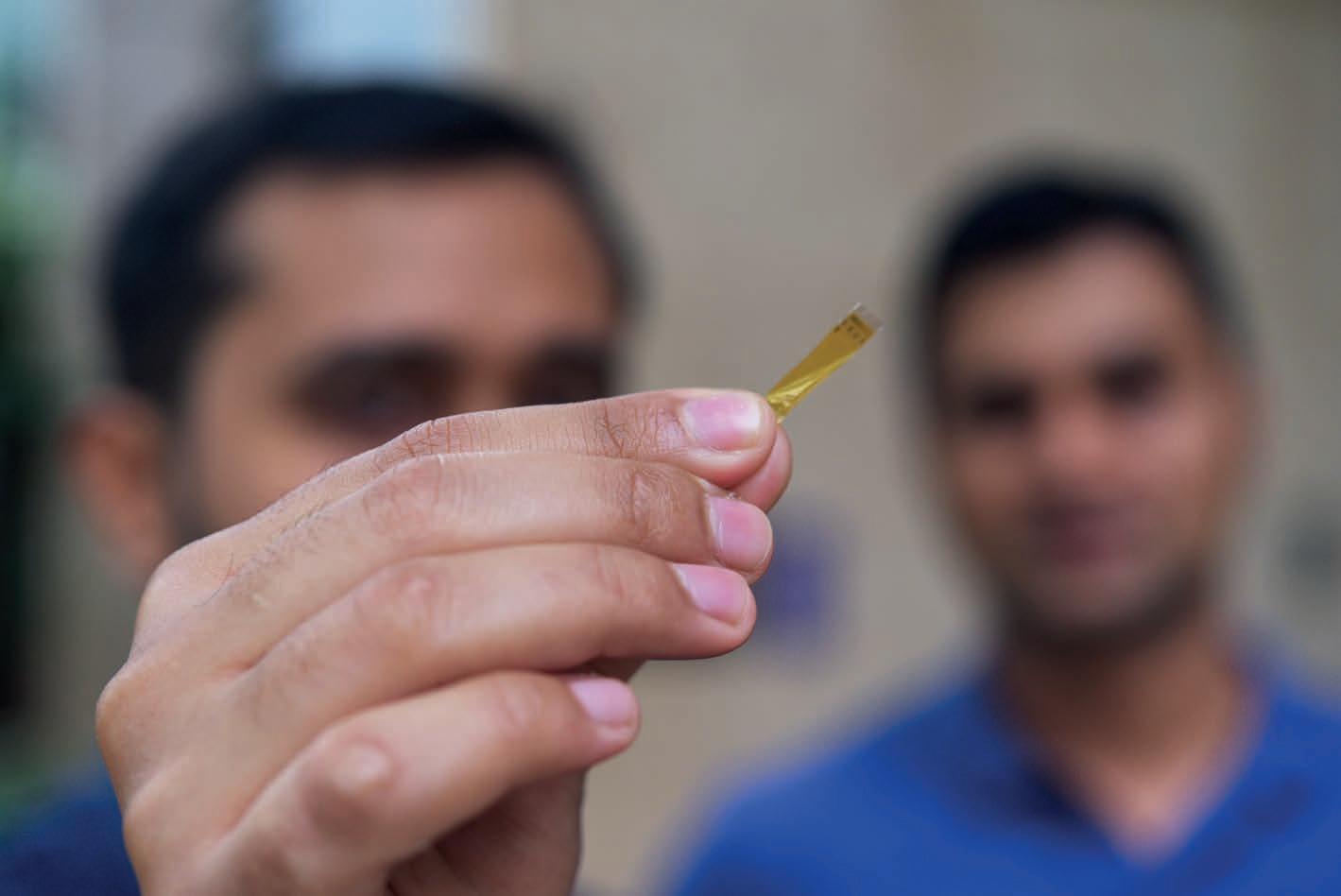
conventional rigid sensors, their flexible gold sensor conforms effortlessly to complex anatomical structures, reducing discomfort, irritation, and the risk of device failure.
The research was pioneered by Professor Yusuke Yamauchi in 2007, senior group leader at AIBN and a professor at the School of Chemical Engineering at the University of Queensland. Professor Yamauchi specialises in the design of novel nanocrystals and nanoporous materials for practical applications.
Dr Masud joined the project in 2016 and Mr Ashok began working on the materials when he began his PhD program in 2019 – 2020. Under Professor Yamauchi’s guidance, they were able to synthesise a mesoporous gold film that acts as an electrode for biosensing and bioimplant applications.
The process behind developing the flexible sensor
Aditya Ashok says they were attempting to make different types of mesoporous materials. Mesoporous materials are nanoporous materials containing pores with diameters between two and fifty nanometres. The AIBN research group is a pioneer in mesoporous structures, not only just with metals, but also with semiconductors, and other mesoporous structures of different pore sizes.
Key advantages of mesoporous materials include:
Ultrahigh surface areas, large pore volumes, tunable pore sizes and shapes.
High surface areas provide large number of reaction or interaction sites for surface or interface-related processes.
24 JULY 2023 Manufacturers’ Monthly manmonthly.com.au
The thin , flexible gold sensor unlocks a new generation of medical implants.
They exhibit nanoscale effects in their meso-channels and on their pore walls.
• Fascinating nanoconfinement effects in the voids of uniform mesochannels, which are advantageous in catalysis and energy storage.
• 3D nano-meter-sized frameworks can produce extraordinary nanoscale effects (surface and quantum effects) that result in unusual mechanical, electrical, and optical properties.
“Our group was focussed on making this mesoporous material, establishing its structural stability, and finding different fields where we could analyse the sample,” said Mr Ashok. “While the structure gave us a better surface area with high sensitivity and scalability based on the deposition method that we used, it had not been tried on a flexible substrate,” he said.
A flexible substrate is important
because it makes it easier to use the material in different non-invasive and minimally invasive, wearable, and implantable applications. Rigid substrates are difficult to use in applications involving direct-touchbased sampling from curved objects.
“Flexible substrates can take on any surface, including curved surfaces, and can be used for diverse applications –not only for biological sensing but also physical sensing. We used a two-step method to translate the mesoporous material onto a flexible substrate. We formulated and made the flexible substrate, and we then translated it for electrochemical deposition,” Mr Ashok added.
“The result we were hoping for was for the material to be flexible, stretchable, and lightweight so it could be mounted onto the human body. It also had to be less expensive, while
Engineering Focus
not compromising on its sensitivity. On the engineering and commercial side of things, the material could not lose its ability to perform and had to be scalable.”
Many researchers in Australia and abroad have attempted to make a similar type of structure on a flexible substrate, but this was a challenging task. Dr Masud and Mr Ashok noted the problems in doing so and worked towards addressing them.

The first step was to translate the mesoporous material onto a flexible substrate electrochemically analyse it biologically and chemically. The researchers then took up a microfabrication method and the mesoporous electric chemical structure formation and combined them together to form these flexible mesoporous structures. The inherent biocompatibility and resistance to
corrosion found in gold make it an ideal foundation for implantable sensors.
“We made the gold design or patterns in micron skin, and then we used those substrates, removing them individually and depositing the mesoporous gold film. After an electrochemical deposition, we used the porous film and we confirmed the structure, and the growth on the 16 micrometre-wide gold electrode and successfully formulated the mesoporous structure,” said Mr Ashok.
“Next, we used the porous structure/ electrode for electrochemical measurements, which meant we needed to detect molecules on the surface of human skin as well as inside mice for bioaction potential. We recorded the signals that were produced by the sciatic nerve muscle of the mice at different intervals and different voltages, comparing its sensitivity to the traditional materials that we use now.”
manmonthly.com.au Manufacturers’ Monthly JULY 2023 25
Professor Yusuke Yamauchi (right), Dr Masud (left), and Mr Ashok (centre) synthesised the novel mesoporous gold film.
Engineering Focus
Additionally, to achieve this, the material would need to have low impedance as the mesoporous material had a large surface area and would need to be flexible as well. To prove this, the researchers subjected was subjected to 1,000 bend cycles and physical strain, in addition to physiological monitoring applications. The result was a breakthrough moment for them – the materials performed twice as better as conventional flat gold samples.
“With these types of metal structures, there are significant problems with cracking. But our technology, in substrates where we deposited our mesoporous gold, despite undergoing several bend cycles, the connectivity and structural integrity was attained for a longer time,” said lead researcher Dr Mostafa Kamal Masud.


It is important to note that fat in the human body is absorbed by any metals implanted in the body. Dr Masud said that until now, no one had attempted to implant these types of substrates in the human body.
“While this is a single material, it has several layers, and each layer is connected to one another. Once implanted in the body, fat begins to deposit on the surface as it always does. But due to the nature of our system, the
fat blocks the top surface, and the inner surface remains active. And the material will work for longer than conventional systems as long as it takes the fat to block the innermost ground layer.”

26 JULY 2023 Manufacturers’ Monthly manmonthly.com.au
Dr Mostafa Kamal Masud (left) and Mr Aditya Ashok have pioneered this groundbreaking research.
The sensor offers seamless integration with a variety of imlant designs from cardiac pacemakers to neurosimulation devices.
Applications in advancing
The exceptional sensitivity of the gold sensor is a game-changer. By enabling precise monitoring of vital signs, biomarkers, and other physiological parameters within the body, healthcare providers can gather comprehensive and accurate data in real-time. This paves the way for personalised and proactive healthcare, where treatment plans can be tailored to individual needs and interventions can be made promptly, ultimately leading to improved patient
There can be two potential applications for sensors such as this one, says Dr Masud, one is a wearable device outside the body and the second is an implantable device inside the body. “In chronic or infectious diseases today such as COVID-19, the most

example is breast cancer, where if we consider a biomarker such as heart to protein, or heart to microRNA – with the progression of the disease over multiple stages, the change in those protein expressions or microRNA is extremely minor,” said Dr Masud.
“Traditional or flat gold sensors may not detect such low levels of changes. And the sensitivity of our materials can detect at the microRNA level as well as the protein level. Therefore, through flexible wearable devices on the outside of the body, we can determine cardiovascular disease biomarkers, as well as glucose and cholesterol.”
For implanted devices inside the body, initial studies have demonstrated promising results for cardiac implants. By seamlessly integrating the sensor into pacemakers and defibrillators, clinicians gain unprecedented access to vital cardiac
Engineering Focus
cardiac events before they occur.
Additionally, the research team is actively exploring the integration of the gold sensor with neurostimulation devices, to advance treatment options for patients with neurological disorders. By closely monitoring brain activity and the response to stimulation, this innovative sensor has the potential to significantly improve therapeutic outcomes for conditions such as epilepsy, Parkinson’s disease, and chronic pain. And finally
“Finally, we have drug monitoring,” said Dr Masud. “In drug delivery, it is important to see how drugs are being released and how they affect metabolic processes in the human body. Since our material has a large surface and several pores, it can be used to load drugs on the surface. These are a few of many potential medical applications.”
Dr Mostafa Kamal Masud says
“The aim of our research is to have practical applications and to do something for society. Therefore, we always encourage collaboration with people who are aligned with similar research areas as us. Dr Hoang-Phuong Phan from the School of Mechanical and Manufacturing Engineering at the University of New South Wales, and previously at Griffith University, was an important collaborator in the broader work we did.
“Me and Aditya – we are physical scientists, focussing on physical and chemical aspects of nanomaterials. And we’ve used our collaboration for biological study. By integrating our expertise with highly specialised bio-scientists, we can always achieve a better outcome.”
As Dr Masud and Mr Ashok continue to refine the flexible gold sensor and explore its potential in other medical fields, they envision a future where the sensor can transform the landscape of healthcare and beyond.
“The potential and possibilities in this field are vast and we will continue to explore them,” concluded Dr Masud.

manmonthly.com.au Manufacturers’ Monthly JULY 2023 27
The reseachers envision a future where the sensor can transform the landscape of healthcare.
Biological and environmentally friendly
GearFluid by SEW-EURODRIVE – 84% less CO2 emission compared to conventional polyglycol lubricants

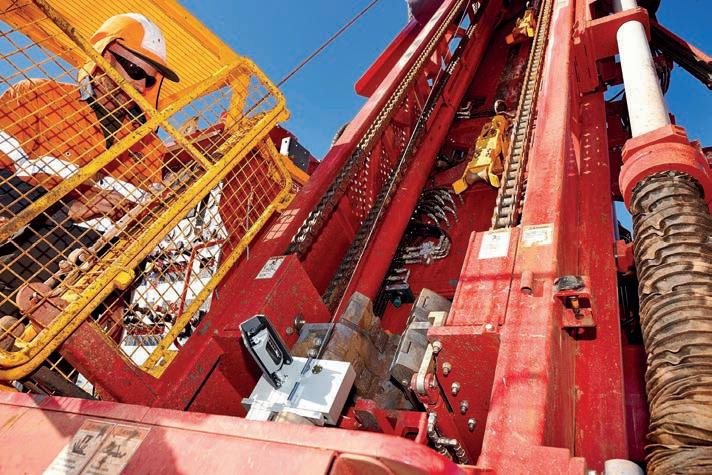
1 Sustainable biomass made from green and food waste, among other things

2 Processing and synthesis of the biomass into the basic oil for the GearFluid

3
4
Mixing in high-quality additives creates the finished GearFluid
Filling the gear units and canisters with GearFluid by SEW EURODRIVE
Data
driven Condition Monitoring makes for the most sustainable Asset Management and Maintenance
Driving the world
www.sew-eurodrive.com.au 1 2
3
4
Additive Manufacturing

Embracing additive to move forward
Manufacturers’ Monthly explores how SQP Engineering has progressed from a sub-contract machine shop to a manufacturing solutions hub with the help of Markforged 3D printing systems.
IN 2006, David Miller began a smallscale jobbing shop, renting out an area within another workshop with a couple NC lathes and a mill. Over the first few years, SQP began to establish itself via its precision-machined products for mining equipment. Being a Western Australian business, mining and oil and gas remain a critical focus, but Miller credits an investment in new automation
and technology as the main reason for SQP’s growth, to a point where it has expanded into producing for industries like agriculture, maritime and defence.

SQP has its own purpose built facility in WA’s Bibra Lake, where it employs and trains local talent to operate high quality CNC machine tools, robotics and additive manufacturing technologies. As an early adopter of industry 4.0 technology,
SQP was the first company in Western Australia to purchase a Markforged FX20, which enables large scale and rapid manufacture of 3D printed composite parts.

“At the time there were two trains of thought – you were either manufacturing or additive manufacturing – and I saw a reasonably large gap where people weren’t doing both,” David Miller explained. “We thought to utilise both skillsets to give the customer the right outcome but also the right choice. Before additive manufacturing, we often had to tell the customer their methods, drawings or even the whole concept and eventual outcome needed to change. That discussion has been turned on its head because you can pretty much do what you like now with the rules of additive manufacturing.”
With a core specialty in machining, SQP was finding itself fielding requests for specialised parts which were either too expensive or outright impossible to machine. To capitalise on these lost opportunities, Miller sought a solution.
A specific challenge kickstarted SQP’s additive manufacturing journey. The team needed to produce a specialised production part for its customer: a
wireline counter cover for mining equipment systems. However, the business was unable to produce the required result in the needed time frame using its existing equipment.
Not only was machining expensive and unable to produce an accurate, fitfor-purpose part, the existing polymer 3D printer was not powerful enough to allow SQP to meet acceptable lead times: each cycle took nine hours. Miller said the older technology produced a suboptimal finish, and after fishing around for the right solution, he decided that a larger and faster composite 3D printer could quickly and efficiently produce these specialised parts. Markforged’s 3D printed systems were the solution. The wireline counter cover, which took nine hours to print, now takes just 2.5 hours. To date, SQP has printed more than 100.
“Printed parts from the FX20 look 10 times better than the ones we printed before,” he said. “Customers are completely blown away when they see the surface finish. Once I showed our customer the new and improved part he was blown away as well. His products now look a hell of a lot better.”
SQP also brought the Markforged Metal X system in-house to round
manmonthly.com.au Manufacturers’ Monthly JULY 2023 29
Markforged 3D printing systems have allowed SQP Engineering to improve its offerings to customers.
To date SQP has printed more than 100 wireline counter covers for the mining sector.
Additive Manufacturing
out additive capabilities. With the FX20 and Metal X in tandem, SQP can be the one-stop shop its customer’s needs, manufacturing a wide range of production-grade parts that no one can machine — while delivering with better pricing and turnaround times.
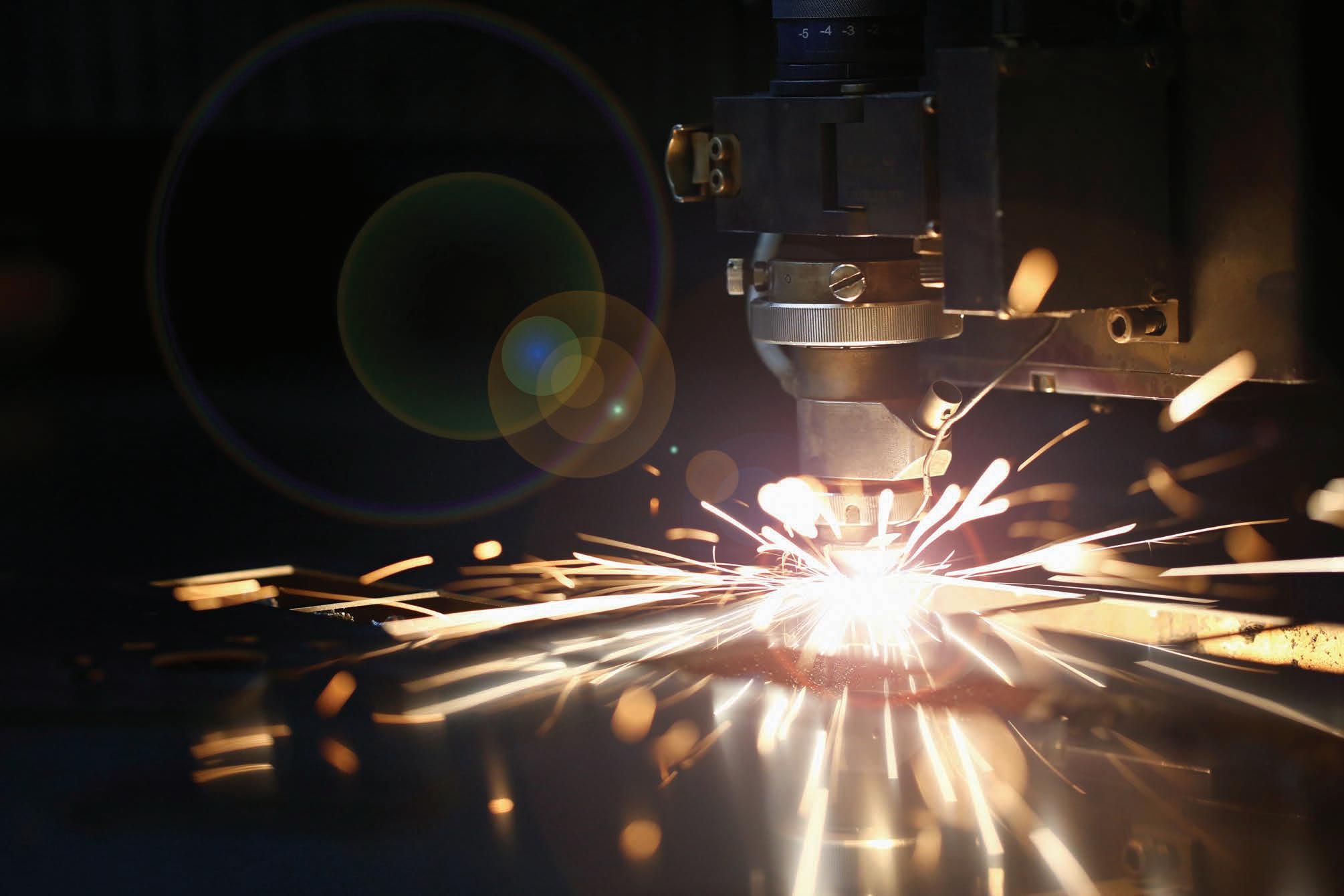
“The FX20 was a no-brainer for me,” Miller noted. “The platform, the build size, the enhanced additive manufacturing technologies — it gives me an edge above a lot of the competition.”
Built to scale distributed global production, the FX20 is precisiondesigned and sensor-driven to deliver breakthrough accuracy, quality and reliability to fabricate parts directly at the point-of-need with the simple click of a button. It is known as the fastest, and smartest 3D printer Markforged has ever produced.

The new technology, alongside high-temperature printing capabilities, elevates the Digital Forge platform from accessible industrial-strength composite manufacturing to robust production applications. The FX20 has a heated build chamber capable of maintaining up to a 200°C temperature and the capacity to print parts up to 525 mm x 400 mm x 400 mm in size.

Richard Elving, Markforged Senior Director for APAC, explained the FX20 is up to eight times faster than the default print settings on Markforged’s existing line of composite printers and prints nearly five times larger builds than its next largest printer, the X7.
“Given our remoteness in Australia, supply chain issues can be costly and time sensitive, and with the FX20 we see this as an enabler of printing parts that will provide a competitive advantage to manufacturers by being able to react quickly to solve problems right on the manufacturing floor,” he said.
“The FX20 will meet the needs of even the most demanding local industries, such as defence, F&B and mining. It is a beast of a machine and represents our commitment to providing innovative solutions to our customers to empower them to build anything they can imagine.”
Front and centre for Markforged is its mission to combine hardware and software to produce end-use, mission critical parts. This mission helps to overcome the limitations of traditional manufacturing, building resilient and sustainable supply chains for local manufacturers. SQP exemplifies this, and David Miller sees the FX20 and Metal
X systems as integral to a future of better solutions for customers. The ability to quickly print a wide array of productionquality parts will allow SQP’s customers to easily get challenging parts that otherwise cannot be easily procured – and give the option to get machinable parts cheaper and faster without compromising quality. Miller is excited about the new doors the FX20 and Metal X system will open for his business.
“We’re planning on using the FX20 to expand into medical, aviation, and agriculture,” he said. “It’s allowing us to expand the horizon a little bit and manufacture more of what Western Australia needs.”
Taking pride in being an early adopter of industry 4.0 and having a technologically advanced machine shop, SQP embraces the cutting edge. He says that everything SQP does, he wants to digitise to make it simpler for the operator – Markforged fits that concept perfectly.
“There’s a required skillset for 3D printing. Not just the modelling, but
a skillset with how you arrange your model, where the holes go and your constraints,” he explained. “The Markforged system makes it user friendly and quite easy for you to figure that out, which has a drastic impact on the outcome of producing successful prints.”
Miller believes that embracing additive manufacturing is crucial to stay competitive now and in the future.
“My two boys work for me, they’re in their first and second years of apprenticeship. I want to continue being more technically advanced than the competition. This technology is evolving as we speak. If I don’t get involved with it, and if I don’t get my boys involved with it, I’ll be letting them and SQP Engineering down at the same time,” Miller said.
“If you’re going to be competitive, you need to have a solution for all aspects of manufacturing. Not just what we’ve been doing yesterday. We need to evolve and embrace the manufacturing technologies of tomorrow as well.”
30 JULY 2023 Manufacturers’ Monthly manmonthly.com.au
The 3D printer dropped manufacturing time down to 2.5 hours.
SQP’s location meant bringing the Markforged systems on board could solve numerous supply-chain issues.

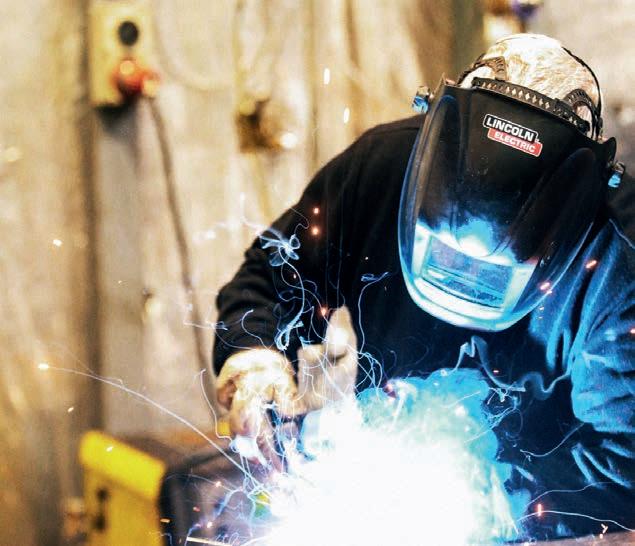
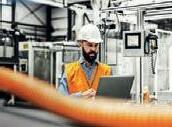


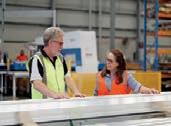


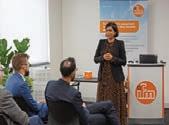


MANAGEMENT >> TECHNOLOGY >> SOLUTIONS manmonthly.com.au For over 59 years, Manufacturers’ Monthly has lead and informed Australia’s manufacturing industries with its highly credible editorial analysis of the market. Visit our website and subscribe to get your print and digital editions in additon to our free daily newsletters today! All Metal Products Australian Made manmonthly.com.au MANAGEMENT >> TECHNOLOGY >> SOLUTIONS >> INSIDE >> An intuitive IIoT platform 41 Start-up blasts into space 28 Official Industry Partners Crafted with Capral 36 Ego story The Pharmaceuticals manmonthly.com.au MANAGEMENT >> TECHNOLOGY >> SOLUTIONS >> INSIDE >> Elexon upskilling for defence jobs 32 JUNE 2023 ifm unlocking digital transformation 28 Onshoring with additive 41 Official Industry Partners To book contact DANNY HERNANDEZ now danny.hernandez@primecreative.com.au | 0431 330 232
Financial Services
Exit planning for manufacturers
Manufacturers’ Monthly meets with RSM’s financial services team to explore how manufacturers can navigate the often-stressful task of selling a business, and what is easily missed when owners start to map out a succession plan.
AUSTRALIA’S manufacturing ecosystem is largely made up of small to medium enterprises (SMEs), most of which started with little resourcing and have grown through the trials and tribulations of economic, supply and labour challenges. A manufacturer’s business is their pride and joy and the realisation of their hard work and ambition.
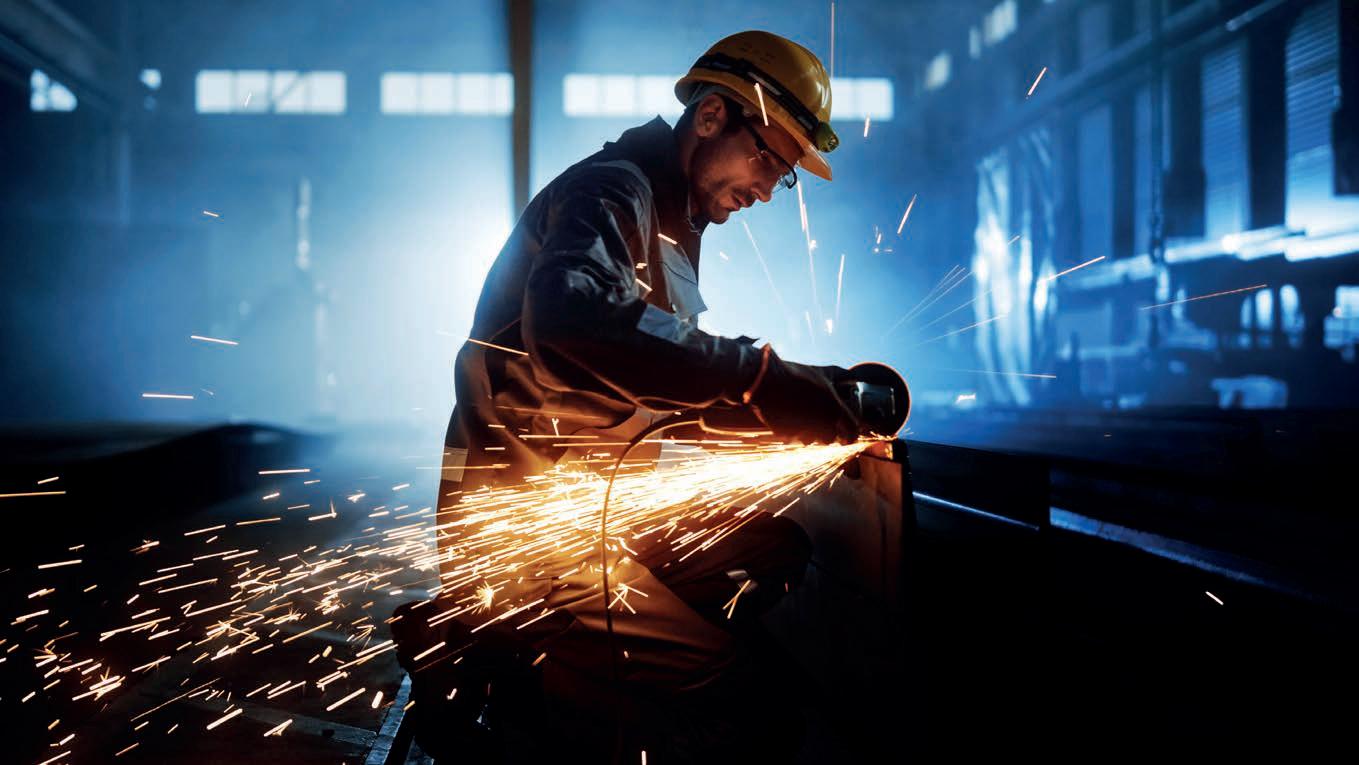
Letting go of this most prized possession is a complicated and sometimes messy journey for local manufacturers. According to professional services firm RSM, it is easy to underestimate the resourcing required to handle what often eventuates to be the most important transaction of someone’s life. The RSM team knows manufacturing, with strong accounting systems, process and records and deep experience in the specifics of valuations, tax advisory and financial modelling in the manufacturing world.
Grace Bacon, partner in RSM’s Financial Services Division, helps clients with personal wealth planning – their own assets, superannuation and succession
plans – working alongside the firm’s accountants and own tax advisors.
“Business owners who are thinking about an exit strategy should be engaging with their financial and tax advisor upfront well before the transaction goes through,” Bacon said.
“That way we can provide the expertise for the right strategy to exit the business gracefully with the least amount of stress as possible, while also avoiding tax implications.”
Considering the time and energy it takes to find a buyer, negotiate a price and work through all the legal processes, it’s imperative to understand the tax implications arising from the sale.
Capital Gains Tax (CGT) concessions are there for small businesses to reduce the tax required to pay on a capital gain on the sale. This is broken down into four categories, Bacon explained.
1. 15 year exemption: A business sale becomes tax free if the business has been owned for at least 15 years, you are aged 55 or older and the sale is in connection with the taxpayer’s retirement.
2. 50 per cent active asset reduction: This concession allows you to treat 50 per cent of the capital gain as tax free, meaning you are only taxed on the remaining 50 per cent of the gain realised.
3. Retirement exemption: A capital gain can be disregarded up to a lifetime limit of $500,000. If you are under the age of 55 at the time you must contribute to a complying superannuation fund the amount of the gain you wish to disregard and treat as tax free. If you are over the age of 55, you do not need to contribute the funds to super and instead can take it as a tax free ETP payment.
4. Small business rollover: which allows the deferral of the capital gains realised from the sale of an active assets of the business where the proceeds are used to purchase a replacement asset or improve an existing one.
“It’s really important for business owners to understand which of these rules applies to them because they may be able to apply for more than one,” said
Bacon. “This is where they need to speak to a tax and financial advisor to work out what is most appropriate for their circumstances. Once you’ve established the taxable capital gains component, then we can consider rolling it into superannuation, and be exempt from the tax liability.” Mark Nichols, RSM Business Advisory division director shed some light on the key considerations for exit planning – put simply, the business owner should establish and understand their own personal investment strategy, personal retirement strategy, personal super strategy and personal debt position and strategies. Once these are understood, it’s easier to know how their lives will be affected by the sale, including the tax implications, access to small business concessions and ability to contribute to super.
“A business owner should understand the implications for them of the proposed structure of the sale, including how the consideration will be taxed,” Nichols explained. “The way the sale is structured can affect the tax outcome, often significantly. This includes selling the
32 JULY 2023 Manufacturers’ Monthly manmonthly.com.au
shares of the company verse selling the assets of the business.”
Where the sale has a CGT outcome the business owner should be aware of what their CGT position will look like, including whether they will have access to concessions on sale, noted Nichols.
“The tax outcomes of the sale will have a significant impact on net cash realised, which ties back to the business owners’ personal financial strategies and understanding that is critical.”
A business owner should consider their personal super strategy, and how that intersects with an impending sale. Are there opportunities to make additional superannuation contributions in advance of sale, concurrent with an individual’s tax and retirement strategy, this can be an effective strategy for all business owners, but particularly for older business owners nearing retirement. Contributions may be eligible for tax concessions, and the funds can be accessed upon retirement with potentially lower next tax outcomes for the business owner.
“For many business owners, the sale of their manufacturing business is the biggest financial transaction of their lives, the realisation of their life’s hard work, and is inherently tied to their financial and retirement strategies,” he said. “Engaging the services of a qualified tax advisor or accountant with experience in business sales transactions to help you plan for the sale, structure it effectively, to understand the tax outcomes, and then to help manage those post-sale is vitally important in ensuring that you generate the best outcome for yourself, and your family, from a business sale.”
Prior to the sale, it may be beneficial to restructure the business to optimise sale outcomes. For a manufacturer this could involve transferring assets, restructuring debt, or rearranging ownership structures. Careful planning and expert advice can help identify opportunities for better outcomes on the sale.

Oliver Gaunt is a principal in RSM’s corporate finance division, specifically in mergers and acquisitions. Having helped a number of manufacturers sell their business, Gaunt mapped out the elements integral to getting the best possible sale, and timing is everything.
“The first thing to consider is around shareholder’s objectives,” he said. “Most buyers will request the seller stays on for a transition period of a at least three
months, some sellers might want to stay a couple years and undertake a partial sale. The question is, what are your objectives do you want to stay with the business for longer.”
Capital investment in the business is a huge factor for manufacturing transactions.
“Owners may be reticent to invest in capital in the lead up to selling the business, but buyers want a business that’s well invested,” Gaunt noted. “If it looks like the buyer will have to outlay significant capital to maintain the existing performance of the business, they are likely to push for a reduction in the purchase price.”
An uptrend in trading and being able to sell a growth story are also crucial to driving up the price. Gaunt suggests that a
Financial Services
strong year after the non-covid ‘normal world’ holds sellers in good stead. When dealing with the sale of a manufacturers life’s work, Gaunt said a well laid out plan can save emotional strain and damage.
“Gradually handing over responsibilities in the business prior to a sale helps free up time to invest in the sale process, and reduces the adjustment once you exit ,” he said. “Having a good advisory team, accountants, lawyers etc. provides sellers with comfort that people are checking for pitfalls throughout the process.”
It’s never all about the business owner when it comes to selling a business. Staff can become family over many years of work together, combining skillsets to achieve a common goal. Rick Kimberley leads
RSM’s Australian Global Employee Services practice, specialising in employment tax and expatriate tax. Whether it’s particular benefits such as cars or one-off payments to employees, it’s important to understand the tax implications. According to Kimberley, superannuation is one which often gets missed.
“Superannuation is payable on what we call ordinary time earnings,” he explained. “Therefore it is not payable on items such as overtime, so there can be a risk that when you give a discretionary bonus – which does not form part of the employee’s termination payment – you might struggle to get it out. You have to be really careful with setting this up so you can look after your staff as you want to.”
manmonthly.com.au Manufacturers’ Monthly JULY 2023 33
A vast array of rules can apply to businesses looking to sell, it is important to know which matter to you.
Augmented Reality
Jigging up product development
The Manufacturers’ Monthly team attended the Melbourne Formula One Grand Prix and spent time in the Alfa Romeo garage with the founders of JigSpace who have been working closely with the team for product releases.

ZAC Duff came up with the concept for Jigspace while teaching game development at a University, when he realised students’ interest dropping after only three weeks.
“The distance education students’ engagement rates would drop off right at the start – within three weeks usually – then it was almost impossible to reengage them afterwards,” Duff said.
Duff and Numa Berton set off on the project together of finding a way to engage their students.
The result was JigSpace. In 2019 JigSpace launched the Jig Workshop, which enabled anyone to create interactive 3D demonstrations with zero coding or technical knowledge. A year later, Jig Pro was launched, giving organisations the tools they needed to
share knowledge with internal teams, key stakeholders, and customers alike.
“We created one of the world’s first live teaching platforms in virtual reality,” Duff said. “It was this awesome environment where students could come together and talk to each other against the backdrop of a big screen, with their own little virtual computers for them to do coursework on.”
“All of the learning material for the course were 2D – PowerPoints and PDF’sso what we did was take 2D information and put it into a 3D world.
“It was a crazy moment, it was this light bulb moment where I realised we experienced the world in three dimensions and almost all of our knowledge is in two – it’s on paper, it’s on a screen.
“I took a Friday off and started prototyping what I thought would be a tool to let me quickly create generic knowledge presentations, so basically PowerPoint for 3D,” he said.
Duff’s 10 years of experience in video game development was invaluable while developing Jigspace, he could see the convergence of hardware and software where devices were compact enough to allow the team to develop the world.
Duff goes on to explain the technology behind the JigSpace program and how it was developed to serve users from start to finish.
“The JigSpace program can be used at any point of a product lifecycle to demonstrate it, but especially in new product development, it’s used quite broadly, but it always starts with the CAD
[computer-aided design] file; it starts with the requirement to share information but the CAD is the key part,” Duff said.
“Jig’s strength lies in its ability to help people understand a complex thing. We have made it as simple as possible for people with enough knowledge to get a CAD file, whether they are an engineer or they are a knowledge worker somewhere else in the chain, they can just bring it in without any hassle.
The process is simple for people to upload, it is compatible all major CAD file types, including OBJ, FBX, STEP, and STL. It can then be customised with annotations, animations, sound, video, and branding and then once it is finalised it can be embedded directly to your website or with a QR code.
“The user opens the file and it’s there
34 JULY 2023 Manufacturers’ Monthly manmonthly.com.au
The JigSpace program was used for the launch of Alfa Romeo’s latest Formula 1 car.
Augmented Reality
in the same way as it would be in their CAD software, it is optimised for real time without them having to do anything,” Duff explained.
“Then the goal is that from there, the user will create those presentations.
“We call it a presentation, but really it’s any kind of sequential step-by-step information about a thing. It could be how to follow a process, how it is assembled, support for a product, it could even be a sales tool,” Duff said.
Manufacturers’ Monthly had the opportunity to attend the Alfa Romeo garage at the recent Formula One Grand Prix in Melbourne, here we learnt how JigSpace helped Alfa Romeo F1 Team to launch the C42 model directly into the hands of their fans.
“F1 teams operate at such a highperformance level under so much pressure, and they do it every two weeks which is crazy, it has been amazing to see how they work and to be a part of the system” Duff said.
“To think that it’s not just a sporting pursuit, even the engineers are part of the sporting team is really impressive, they are under the same pressure as those sporting stars.
“Alfa Romeo aligns really nicely with what we do and I think that’s the visibility it gets us is certainly one thing, but I think fundamentally, it’s a great alignment of what we do,” he explained
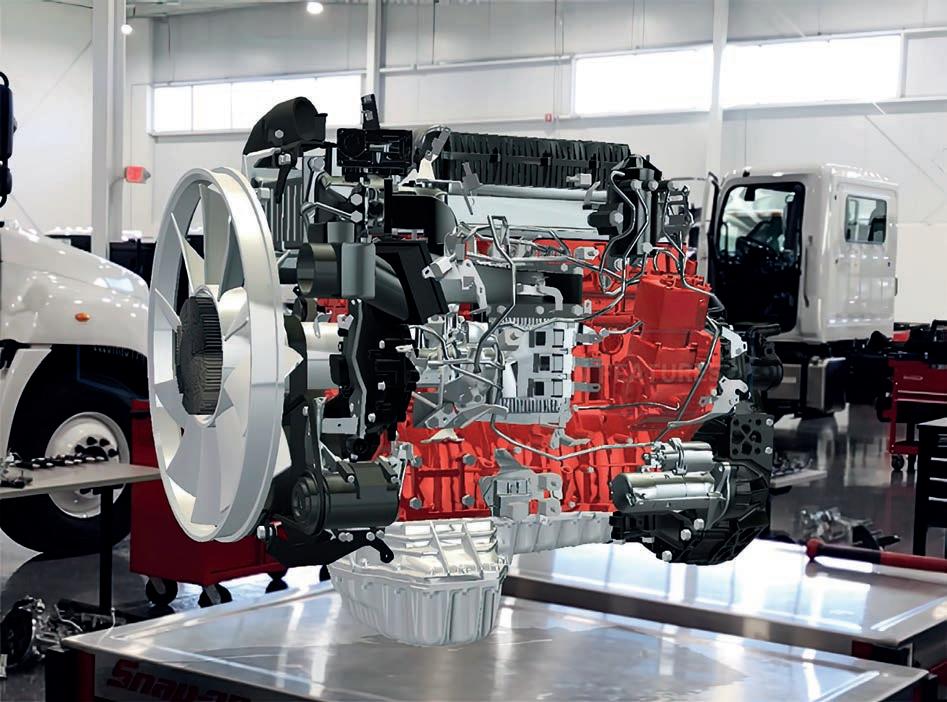
The goal was to build as much fan engagement and brand visibility as possible for the start of the new 2022 season and the launch of the C42 utilising the JigSpace system.
As one of the smaller F1 outfits, resources for large-scale marketing and above the line campaigning was limited. The strategy was built all around the
innovation approach and boosting the Alfa Romeo F1 Team Orlen brand in a ‘turning heads’ style.
All the new F1 cars are unveiled with beautifully shot, cinematic videos, shared and reshared across their social media channels. The Alfa Romeo F1 Team Orlen outfit was looking for more innovative ways to launch the C42 directly into the hands of the fans using innovation and technology that would make fans and the F1 world sit up and take notice.
UK based company Automata has used the JigSpace platform to show the companies ability to customise a solution using its product.
Automata aims to transform the way
labs work with open and intergrated automation, most lab automation tends to be defined by a series of very specialised benchtop instruments that are still reliant on human interaction. But Automata saw an opportunity for a new way of looking at automation in the life sciences: open, integrated automation.
“They started using it for free, and then they started going through the process, they got on the first business tier license, so they could share it internally with their team and from there, they just started expanding,” Duff said.
“The team used the system to quickly communicate internally and to also show customers how they could customise a solution for them quickly without having to mock-up these on Photoshop.
“Automata been using JigSpace for about nine months now, and they just keep going from strength to strength.
“It’s used throughout their organisation, it is reducing sales cycles from six months down to six weeks,” he said.
Looking to the future, Duff and the team at JigSpace is excited for the prospects for the company.
In June JigSpace was featured in the Apple Vision Pro announcement, showcasing its collaboration with the Alfa Romeo F1 Team.
The Vision Pro defines a new paradigm of computing that harnesses the space and environment around us, and JigSpace is at the forefront of this shift.
All content created on the JigSpace platform will seamlessly work on the new device, just like it does today when viewing a Jig on any smartphone.

Duff and the team at JigSpace believe they match up with many of its clients well as they are innovators in the same way and that is how they can deliver a quality product.
“That’s a differentiation for us, our customers expect that, they appreciate that, and they want to be able to give that level of customer experience and employee experience. So internally, they’re able to share and communicate at a higher level than they were before. So that’s where we are really helping those companies,” Duff said.
“I think in the end, what we are really focused on at the moment as a company, is that our customers get that value that they need out of the product and they get to get there really, quickly by using it themselves.
“I mean, really it speaks to those change makers, the ones who want to do things differently, who want to take that big step forward,” Duff said.
“So, I’m very excited about the fact that Australia is moving in that direction.”
manmonthly.com.au Manufacturers’ Monthly JULY 2023 35
The program can be used for both product development in house and product displays for clients.
The JigSpace program is extremely customisable for users.





3 TICKETS ON NOW! SALE AUSTRALIA’S LEADING MANUFACTURING AWARDS endeavourawards.com.au IN PARTNERSHIP WITH
AMW wrap up
Australian Manufacturing Week 2023 reverberations
Australian Manufacturing Week 2023 (AMW2023)
AMW2023 is done and dusted.
And what a show it was. It’s been four long years since the last Melbourne Austech show, due to COVID restrictions and lockdowns.
Now fully owned and operated by AMTIL, AMW is Australia’s largest manufacturing solutions event, bringing far more sectors of Australian manufacturing under the same roof.


Seven distinct zones represented different areas of the manufacturing world including the original Austech Machine Tools Zone, Additive Manufacturing, Robotics & Automation, Australian Manufacturing, Manufacturing Solutions, Plastics Technology and Weld & Air Technology.
AMW2023 just about took over all the halls of the MCEC, and filled them to the brim with the very latest technology in manufacturing, filling 10,900 sqm of show floor space.
In fact, 348 companies joined the show, and Exhibitors attended from here and around the planet. People from 46 countries came to the show!
All up, 773 individual brands were promoted by the Exhibitors in the Map Your Show digital directory. Around 1535 people downloaded the AMW Mobile App, and all the feedback we’ve had, proves it was very helpful throughout the show. And a total of 19,236 My Show Planner profiles were created by visitors.
In preparation for the show, 17kms of electrical cable was laid, 1,500 light
fittings were installed, and we had 1,018 hours of security employed.
Well over $80m in manufacturing technology was spread out on the floor and demonstrated over the four very full days. For the show, in fact almost 11,000 sqm of floorspace was sold in record time. We had over 500 students from various schools visit the show in organised groups, and we recycled over 12 tonnes of metal during the show.
AMW2023 visitors
• Total: 15914
Australia: 15,530
• Other: 384 Day by Day
• Day 1: 2757
Day 2: 4439
Day 3: 5953
• Day 4: 2765
It really was a spectacular celebration of what Australian manufacturing and all associated industries can do here on shore, here in Australia.
The feedback from those who took part has been humbling and heartfelt. AMTIL has extended thanks to everyone for attending the event and already have special plans for a big Sydney show coming up in April for AMW2024.
Events and networking
The success of the Future Solutions Speaker sessions took all by surprise. Such a successful reaction. Each of the days had a special theme, and the program was filled with great special focus speakers, MC-ed to perfection by Warrick Merry. The immediate reaction was a full deck of filled seats and standing room only.
Day One’s theme was Additive Manufacturing, proudly sponsored by AMHub, celebrate the various innovations and constant developments that are sweeping this particular segment of the manufacturing industry in Australia.
AMTIL followed up with a wonderfully raucous networking event down along the Yarra at the Munich Brahaus, supported by AMTIL, open for the Exhibitors to unwind.
Day Two promoted and recognised the various achievements of women in the manufacturing sector in
Australia.
Australia. There were panels from Commonwealth Bank, Geelong Manufacturing Council, William Buck and SEMMA. Later in the day, a special networking event, sponsored by the Queensland Government, was a huge success.
The Third day was a celebration of Australian Manufacturing, proudly sponsored by Autodesk.
The presentations from Autodesk Australia, Bosch Australia, Adobe, Rigby Cooke, ANCA and the Victorian Government. An even more special networking event was rallied up for the VIPs at the end of the day’s proceedings, sponsored by the Moreton Bay Regional Council.
The final day’s presentations focussed in on Innovation and research occurring here with the view of the future of manufacturing.
Sessions with Monash Smart Manufacturing Hub, Geelong Manufacturing Council, Breakthrough Victoria and the ANFF were tremendous opportunities for those present to learn about the long strides happening right now in preparation for the next 30 years of manufacturing in Australia.
Australian Manufacturing Week returns next year in Sydney, 17-19 April 2024 at Darling Harbour.
Capral’s eye-catching stand
As part of its Australian Manufacturing Week display Capral commissioned Western Australian Artists Carol Stevens and Albert De Boer from Artforms WA to produce a sensational aluminium globe. The globe is made from a selection of Capral aluminium profiles and plate.
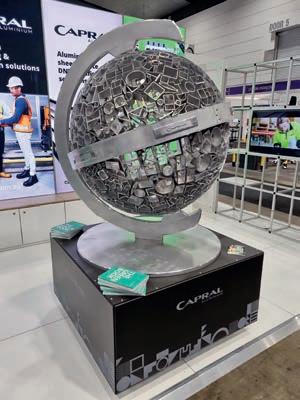
Atlas Copco displays a range of compressors
During the event, Atlas Copco showcased its latest products and technologies.
GA VSDs screw compressor
The GA VSD, the most energy-efficient compressor on the market with energy savings up to 60 per cent compared to fixed-speed models. The GA VSDs offers optimal performance, reliability and connectivity to support your sustainability and productivity goals.
NGM+ nitrogen generator
The nitrogen generator, the NGM, provides continuous supply of dry, highquality nitrogen with a stable purity. The generator is an excellent solution for on-site nitrogen generation
GA screw compressor
The GA screw compressor delivers outstanding performance, high
grew into a tremendous success, truly a celebration of the manufacturing talents here in
manmonthly.com.au Manufacturers’ Monthly JULY 2023 37
Victorian minister for industry and innovation, and minister for manufacturing sovereignty Ben Carroll opened the event
Capral’s aluminium globe caught the attention of many attendees.
AMW wrap up
productivity and low cost of ownership. It offers optimal performance and flexibility while reducing energy costs.

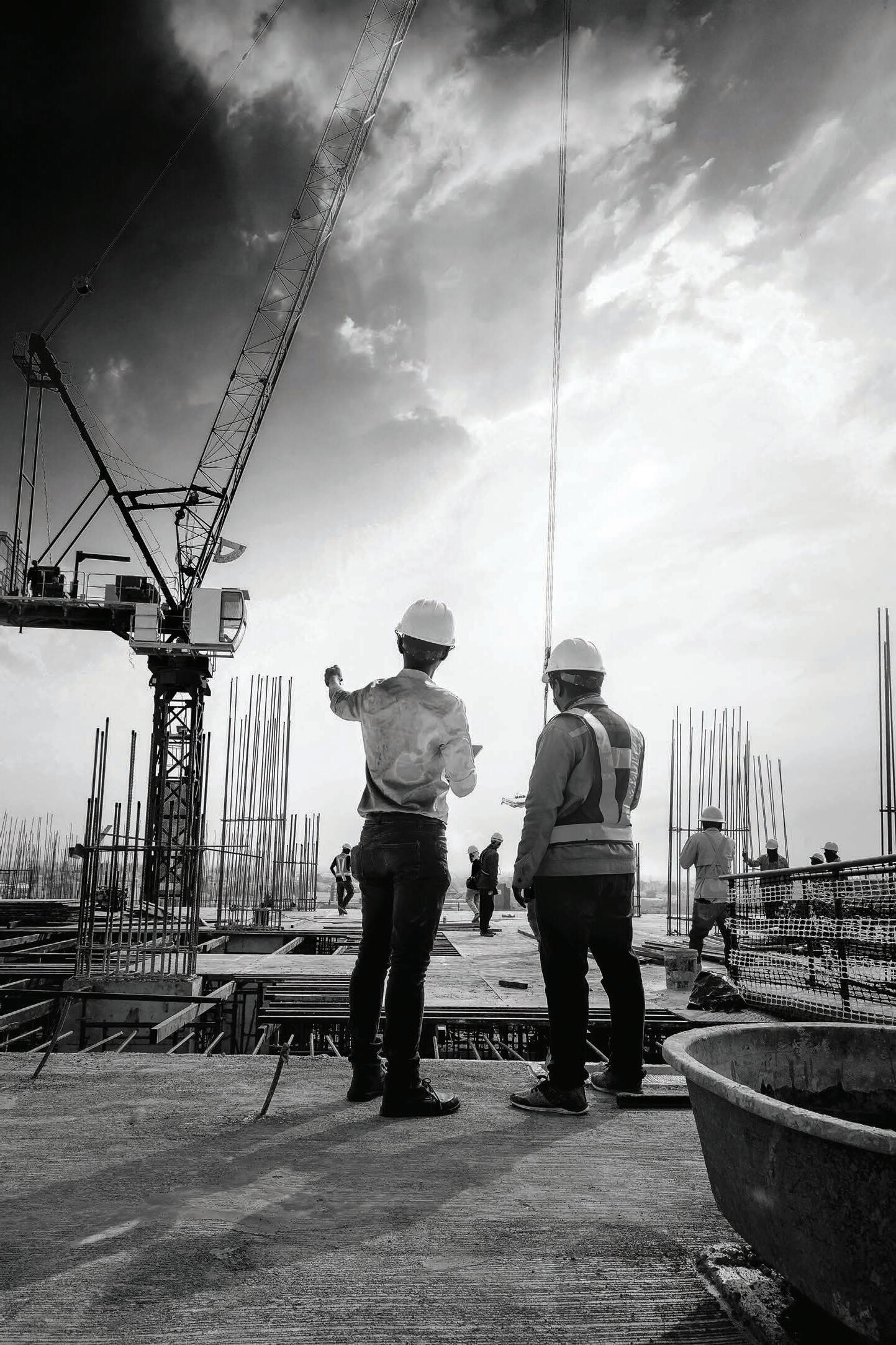
GA VSD screw compressor
The GA VSD+ screw compressor is an excellent solution for reducing energy consumption by an average of 50 per cent while ensuring uptimes even in harsh operating conditions.

SF oil-free compressor
The SF compressor delivers pure oil-free air with supreme energy efficiency in a small package, resulting in a small footprint.
OSC oil-water separator
The OSC series of oil-water separators provides an unmatched solution for condensate treatment. Its multi-stage process achieves superior filtration precision, meeting or exceeding local regulations for discharge into the environment. With zero-hassle maintenance requirements, these units offer a reliable and sustainable choice for compressor operators.
Bringing women into manufacturing
During Australian Manufacturing Week the South East Melbourne Manufacturers Alliance (SEMMA) hosted a panel on Women in Manufacturing: Courage, Leadership and finding our North Star during the day two of the event.
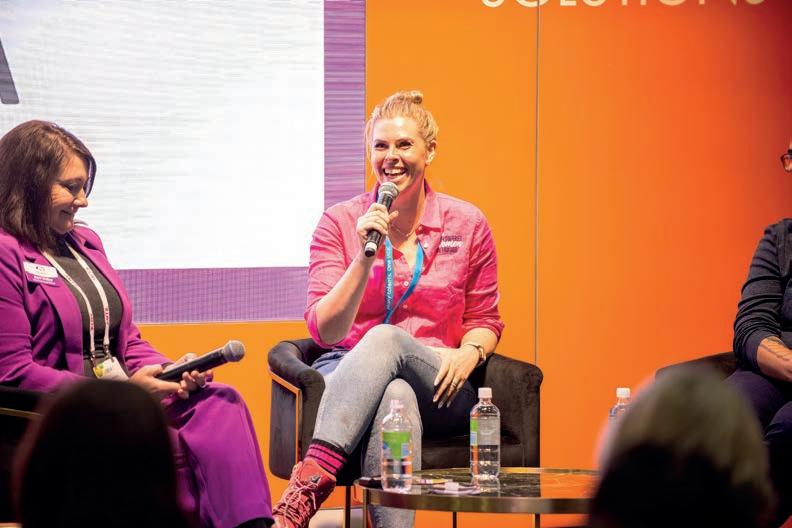
The Manufacturers’ Monthly team sat
in on SEMMA’s presentation with Honi Walker CEO of SEMMA, apprentice Emma Mokalei and EWIT CEO Hacia Atherton all speaking.
Walker started by explaining there are ample opportunities for different cohorts to enter the workforce.
“Kids who don’t want to go to University, migrants or women reentering the workforce are all looking for secure, safe and sustainably progressive work. We need to attract more people and we are a part of a wider campaign doing that,” she said.
Emma Mokalei is an electrical apprentice at SEMMA member, Essity in Springvale. Mokalei recently won the apprentice of the year award and is close to finishing the first year of her apprenticeship with Essity.
Essity is a leading personal care and hygiene company that manufactures, markets, distributes and sells essential everyday consumer products across the Feminine, Incontinence and Baby Care, Consumer Tissue and Professional Hygiene product categories.
Mokalei spoke of growing up in New Zealand in and around rugby, meaning the prospect of entering a workforce with a larger male contingent was not intimidating to her.
“I found myself at an apprentice introduction school in Warragul where I got introduced to welding, plumbing, carpentry and electrical work and I fell in love with electrical work,” she said.
“After bouncing around a number of
jobs I found myself at Essity completing my electrical apprenticeship .
“Working at Essity I see 800 pads go through a minute and for me it was quite ironic seeing men opening up these packets to check the quality of our product. These men have feminine hygiene products in their pockets, they will pull out their phones and pads are falling out, I love it,” Mokalei chuckled.
“It is amazing, I love it, the work is not dirty - the work is not dumb and the people I work with are some of the brightest people I have ever met,” she
Mokalei is a shining example of women joining industry and falling in love with it, she felt incredibly welcomed and the men at Essity treated her with the same respect and expectations they would
“From the moment I walked in I was not treated any differently and it was invaluable for my learning, I cannot have asked for a better environment,” she said.
Hacia Atherton is an impressive member of the manufacturing sector and is the founder of empowered women in trades. She explained her unconscious bias that saw her completing almost
all roles in the family business except working on the factory floor.
“It took a lot of courage for me to put down the Excel spreadsheets, lace up my pink steel cap boots, and put on the Hi-Viz and to go into the factory for the first time and I was scared. Even though I’d grown up in this company, I knew a lot of the people in the factory, I was doubting myself,” Atherton said.
“Manufacturing is a welcoming environment, and this is something we are not very good at probably promoting and talking to people outside of the industry.
“It’s not just women that lead that culture. It’s the men, the amazing men in there. And when I started my experience in the factory, I was taken under the wing of some very fantastic tradesmen. I fell in love with welding, and the tradesman that I was working under spent time to teach me, was patient in teaching me, would point out my mistakes, and he was an amazing teacher,” Atherton said.
The SEMMA presentation was a glowing example of women in Victoria working in manufacturing and how it can benefit both themselves and the businesses they work for.
38 JULY 2023 Manufacturers’ Monthly manmonthly.com.au
The Atlas Copco stand was well attended during AMW.
Hacia Atherton spoke of her experience transitioning to the factory floor in the family business.










Melbourne Convention and Exhibition Centre 20-21 Sept 2023 CONFERENCE SPONSOR ASSOCIATION PARTNERS SUPPORTING SPONSOR EXHIBITION SPACE NOW ON SALE Melbourne’s leading construction and major infrastructure event insideconstructionexpo.com.au Get your share of major infrastructure projects
What’sNew
Heavy-duty flow meter resists corrosive biogas in co-gen green power environments
The ST51A Biogas Flow Meter from FCI combines superior measurement accuracy with high reliability and dependability in corrosive gases.

Organic waste such as food or meat processing plants, fermentation systems for dairy products or wineries and breweries, as well as on-farm manure, and sewage treatment plants, is often digested under anaerobic conditions in reactor tanks. The output is valuable biogas, which is measured with flow meters to support green co-gen energy systems or for disposal by flaring.
Organic waste creates a potent mixture of combustible methane (CH4), carbon dioxide (CO2), water and trace levels of corrosive hydrogen sulphide (H2S), gas is problematic for many flow measuring technologies. The combustible properties of CH4 gas require HazEx safety approvals. In addition, the corrosive, sticky nature of the H2S particles affects the performance and can clog many flow sensors, leading to frequent, labour-intensive cleanings.
With its no-moving parts thermal dispersion gas mass flow sensor, the ST51A Biogas Flow Meter is designed specifically for dirty, potentially hazardous biogas processes. It provides system operators with highly accurate and repeatable mass flow measurement to facilitate system control, log gas production data and provide mandated safety and environmental reporting information.
It comes standard with rugged 316 stainless steel body construction and Hastelloy-C22 thermal sensors. It features a no-moving parts, non-clogging design which eliminates the need for constant cleaning under wet, dirty biogas conditions. The ST51A meter carries the CE mark and is available with Div.1/Zone 1 Ex agency approvals of FM, FMc, ATEX and IECEx.
Additionally, it has been independently verified to meet International Electrotechnical Commission’s (IEC) standard IEC 61508 for Safety Integrity Level (SIL-1) rating. With all these pedigrees and verifications, FCI is further able to extend a full 2-year warranty to all customers.
This meter’s advanced electronics are housed in a durable NEMA 4X, IP67 dust/water ingress protected all-metal (aluminium or 316L stainless steel) enclosure with dual conduit ports in either NPT or M20 threading. The transmitter can be integrally mounted with the flow element (probe) or can be remote mounted for installation flexibility. The instrument comes standard with dual 4-20 mA, NAMUR NE43 compliant outputs and a 500 Hz pulse output.
Company: AMS Water Metering Pty Ltd
Phone: 03-8577 8000
Website: www.amswatermetering.com
Aplex AVS-320 Compact Fanless Machine Vision Box PC
Interworld Electronics is excited to announce the AVS-320 Compact Fanless Machine Vision Box PC from APLEX technology. The AVS-320 is purpose built for factory automation, smart industry and machine vision applications. With its compact size, rugged/fanless design, high-speed powerful computing abilities and wide range of additional features, the AVS-320 is an ideal solution to suit a wide variety of applications.
The AVS-320 is powered by the Intel Celeron J6413 quad core processor and supports up to 16GB SoDIMM DDR4 memory. It has two USB3.1 and two USB2 ports; one RS-232 and one RS-232/422/485 serial port, a VGA and HDMI graphics output port; one GbE and two GbE PoE LAN ports; 8-bit digital I/O; and one M.2 Sata port and one M.2 expansion slot. With all of this I/O, the AVS-320 can easily integrate with machine vision cameras and other peripheral devices to collect and analyse image data in real-time. It also supports firmware TPM 2.0, which offers improved security, as well as many other benefits.
The AVS-320 is a rugged, durable and reliable fanless system that features a tough casing (aluminium heatsink and steel chassis) and an operational temperature range of -20°C to 70°C. It supports 24V DC input and is extremely compact (180 x 130 x 55mm), making it an ideal space-saving option.
It is extremely flexible and easy to configure with a range of adaptable options. It also has support for both Windows 10 & 11 and has the ability to be DIN rail mounted, providing even more versatility to the range of options that are available. The wide range of features of the AVS-320, including the flexible and extensive I/O support, makes it ideal for a wide variety of applications, and the rugged design means that it will continue to operate even in harsh industrial environments.
Key Features:
• Celeron J6413 Quad Core Processor
Wide Operating Temp of -20 ~ 70˚C
• 3 x GbE LAN ports including 2 x PoE ports

Supports up to 16GB SoDIMM DDR4
Supports Windows 10 and Windows 11
Compact Size (180 x 130 x 55mm)
DIN Rail Mount
Company: Interworld Electronics
Telephone: 03 9593 7555
Website: www.ieci.com.au/
40 JULY 2023 Manufacturers’ Monthly manmonthly.com.au
What’sNew
iBase’s AMS312 compact expandable fanless system with 10th Gen Intel Core i7/i5/i3 desktop processors (35W TDP)
The iBase AMS312 is a compact and expandable fanless system designed for versatile industrial applications. Powered by 10th Gen Intel Core i7/i5/i3 desktop processors with a 35W TDP, this system delivers reliable and efficient performance.
The AMS312 features the IBASE MB310 customized board and offers a front removable drive bay for HDD/SSD, providing convenient storage options. It also includes 1x PCI-E (x8) and 1x PCI-E (x4) expansion slots for additional flexibility in expanding the system’s capabilities.
With over/under/reverse voltage protection, the AMS312 ensures the safety and stability of the system in challenging operating conditions. It supports DIN-rail mount and wall mount options, allowing for easy installation and integration into different environments.
Equipped with TPM 2.0, the AMS312 provides enhanced security for data protection. The system’s rear panel external I/O features multiple connectivity options, including HDMI, DisplayPort, USB ports, audio jack, Ethernet ports, and serial ports, enabling seamless integration with various devices and peripherals.
Built with an aluminum and steel construction, the AMS312 offers durability and reliability in industrial settings. It supports desktop or wall mounting, and optional DIN-rail mounting for flexible installation.
With its compact size of 275mm (W) x 150mm (D) x 117mm (H) and a weight of 3.5kg, the AMS312 is designed to fit in space-constrained environments without compromising performance. It operates reliably in a wide temperature range of -10°C to 60°C with airflow or -10°C to 50°C without airflow, making it suitable for demanding industrial applications.
Certified with CE, LVD, and FCC Class B (TBD), the iBase AMS312 meets industry standards for safety and electromagnetic compatibility.
Overall, the iBase AMS312 combines compact design, expandability, and reliable performance, making it an ideal choice for industrial applications that require a fanless system with powerful computing capabilities.

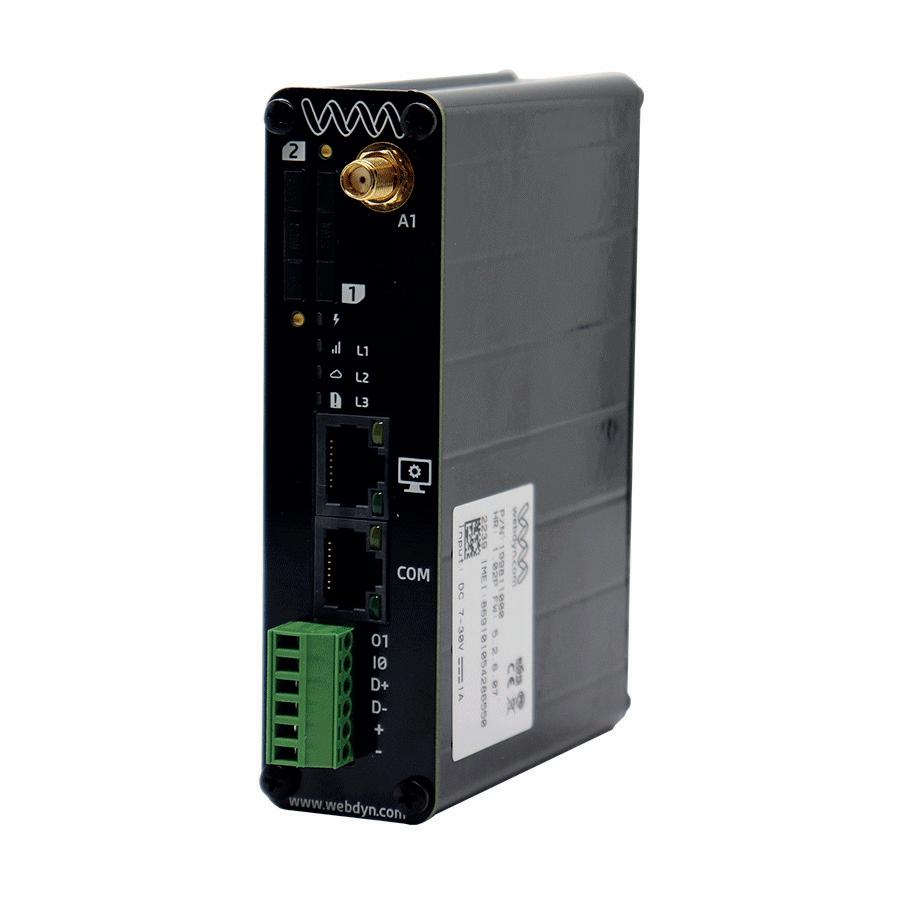
Key Features:
Compact fanless system with for IBASE MB310 customized board
10th Gen Intel Core i7/i5/i3 Processors (35W TDP)
• Front removable drive bay for HDD/SSD
1x PCI-E (x8) + 1x PCI-E (x4) expansion slot
• Over/Under/Reverse voltage protection
Supports DIN-rail mount & wall mount
• TPM 2.0
Company: Backplane Systems Technology
Phone: (02) 9457 6400
Website: www.backplane.com.au
New Webdyn EasyTunnel 4G IoT Modem
The new Webdyn EasyTunnel 4G is a powerful all-in-one IoT solution for demanding industrial, agricultural, utility and environmental applications.
With RS232, RS485, dual SIM and digital I/O interfaces, plus new embedded TITAN V6 firmware (Modbus, MQTT, IPSec, logger, Webserver…) the unit provides the required functionality for many complex IoT projects.
A key feature of the new Webdyn EasyTunnel is the userprogramable scripts, based on JAVASCRIPT, that permit easy programming of customised functions for specific applications (edge computing). Additional functions include FIFO/LIFO modes for data queuing, SSL/TLS support, and data sending options (HTTP/ HTTPs/FTP/FTPs/MQTT/MQTTs) with custom JSON formats.
Webdyn’s Titan V6 firmware with an embedded webserver to make configuration and setup simple and quick, additional features of the Titan V6 firmware include:
2 simultaneous 4G<->RS232/485 connections
• Serial data collected by RS232 or RS485(Modbus, sensors, meters, I/Os…)
Full control by SMS with phone number authorizations
Alarms (digital input, temp., MBus data read)
• Full management with AT Command by serial, socket, SMS, modbus, SNMP, …
• SSH encryption enabled, supports TACACS+ Protocol IEC 60870-5-102 for meter reading
The above EasyTunnel features make the unit applicable to endless IoT projects, and ideal for Industry 4.0 applications, examples include:
Gathering data from electrical meters
• Monitoring solar/Photovoltaic systems
Monitoring frequency drives used in pumping or other applications
Temperature/humidity monitoring
• Irrigation pump control and monitoring plus water metering
Company: Australis M2M
Ph: 0477 141 967
Website: www.australism2m.com.au
manmonthly.com.au Manufacturers’ Monthly JULY 2023 41
The Last Word
Future of jobs — rise to the challenge or risk being left behind
THE World Economic Forum’s latest Future of Jobs report, released last month, has brought together the perspectives of 803 companies, collectively employing more than 11.3 million workers, across 27 industry clusters in 45 economies around the world.
This significant international survey has painted a picture of an enormous jobs and skills churn over the coming years, predicting that 23 per cent of jobs are expected to change by 2027, with 69 million new jobs created and 83 million eliminated.
As the Australian partner, Ai Group contributed the perspectives of our members to this landmark report – the fourth edition following its launch in 2016. It aims to analyse how macrotrends as well as technology adoption are likely to reconfigure labour markets and shape the demand for jobs and skills in the 2023-2027 timeframe.
In this 2023 edition, the green transition, Environment Social and Governance (ESG) standards and localisation of supply chains, are the leading drivers of jobs growth, with economic challenges including high inflation, slower economic growth and supply shortages posing the greatest threat.
The fastest growing jobs are artificial intelligence (AI) and machine learning specialists, sustainability specialists, business intelligence analysts and information security specialists. The largest absolute growth is expected in education, agriculture and digital commerce.
The insights from this report highlight the enormity of the skilling and re-skilling task ahead – for our economy and many others around the world. Overall, the message is clear – the global workforce is in for a bumpy ride.
Advances in technology and the transition to a clean economy will cause great upheaval in jobs and skills over the next five years, but there is great scope for growth, too.
This is a warning to us all — industry, government and the education and training system — to get the policy settings right to meet these challenges, or risk being left behind.
Technology driving jobs churn
The data suggests technology adoption and digitisation will cause significant labour market churn — but result in net job creation.
Big data ranks at the top among technologies seen to create jobs, with 65 per cent of survey respondents expecting job growth in related roles. The employment of data analysts and scientists, big data specialists, AI machine learning specialists and cyber security professionals is expected to grow on average by 30 per cent by 2027. At the same time, the fastest declining roles are also being driven by technology and digitalisation, with clerical or secretarial roles including bank tellers, cashiers and data entry clerks expected to decline fastest.
Automation shifting from manual to cognitive tasks

The 2023 report suggests tasks are no more automated now than they were three years ago. About a third of tasks (34 per cent) are currently automated, just 1 per cent above the 2020 figure. Surveyed companies also revised down their expectations for further automation, to 42 per cent of tasks by 2027, compared to 2020 estimates of 47 per cent of tasks by 2025.
But while expectations of the displacement of physical and manual work by machines has decreased, reasoning, communicating and coordinating – all traits with a comparative advantage for humans – are expected to be more automatable in the future. AI is expected to be adopted by nearly 75 per cent of surveyed companies and is expected to lead to high churn – with 50 per cent of organisations expecting it to create jobs growth and 25 per cent expecting it to create job losses.

Rise of green, education and agriculture jobs
Investment in the green transition and climate-change mitigation, as well as increasing consumer awareness of sustainability issues, are driving industry transformation and opening new opportunities in the labour market. The strongest net job-creation effects are expected to be driven by investments that facilitate the green transition.
Roles including renewable energy engineers and solar energy installation and systems engineers will be in high demand. Investment will also drive growth in more generalist sustainability roles, such as sustainability specialists and environmental protection professionals, which are expected to grow by 33 per cent and 34 per cent respectively, translating to growth of approximately 1 million jobs.
However, the largest absolute gains in jobs will come from education and agriculture. The report finds that jobs in the education industry are expected to grow by about 10 per cent, leading to 3 million additional jobs for vocational education teachers and university and higher education teachers. Jobs for agricultural professionals, especially agricultural equipment operators,
graders and sorters, are expected to see a 15 per cent to 30 per cent increase, leading to an additional 4 million jobs.
The challenge for industry
The report predicts six in 10 workers around the world will require retraining or upskilling by 2027, but only around half of workers are seen to have access to adequate training opportunities today. The challenge is huge. The businesses surveyed said skills gaps and an inability to attract talent were the key barriers to industry transformation.

When asked what they planned to do about it, there were two top answers: investing in learning and training; and accelerating the automation of processes. The upshot: many workers will need to be upskilled, and many will find themselves replaced.
The question is, are we ready? Can our education and training system upskill workers efficiently and effectively? Do we have the policy settings to ensure those replaced by machines can re-skill and find new ways to contribute? If not, let’s get on to it – now.
Access the Future of Jobs Report, and snapshots of the global datasets here: www.aigroup.com.au/ news/reports/2023/future-of-jobs-report-2023/
INNES WILLOX –
42 JULY 2023 Manufacturers’ Monthly manmonthly.com.au
Chief Executive of the national employer association, Ai Group
Ai Group contirbuted to the World Economic Forum’s job report on behalof of Australian companies.
AUTOMATION AND ROBOTICS
With labour shortages continuing to pose a challenge to businesses, automation and robotics are becoming pivotal to support industry.
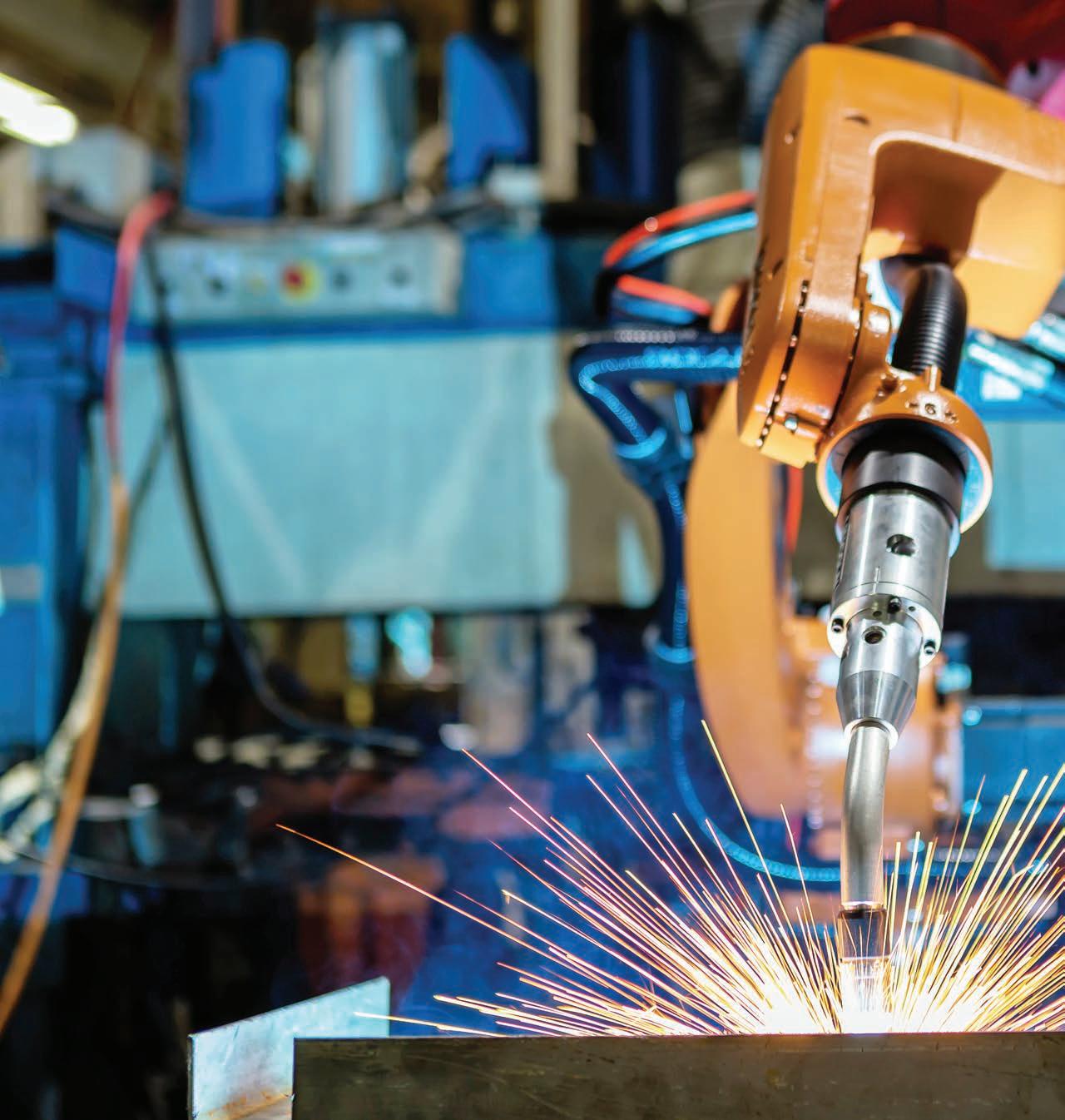

In October 2023 – we will showcase businesses who supply machines for automation and robots which are fast becoming a pivotal part of the industry. The edition is an opportunity for business to demonstrate the extent of their services in this space.
In every edition of Manufacturers’ Monthly, we’re proud to work with our commercial partners on content that helps connect you with your future customers.

Booking deadline: 31 August 2023
To book contact DANNY HERNANDEZ now
danny.hernandez@primecreative.com.au | 0431 330 232
your Complimentary 3D Printed Part*
Are you looking to innovate faster and reduce supply chain issues by 3D printing everything from prototypes to end-use parts?

We got you covered!
At Markforged we are on a mission to bring industrial manufacturing to the point of need. To help manufacturer reduce lead time we are offering a Complimentary 3D Printed Part*, for a limited time only, to encourage manufacturers to improve their production processes. See for yourself the unmatched surface finish, strength and precision of our 3D printed parts in metals and continuous-fiber reinforced composites.
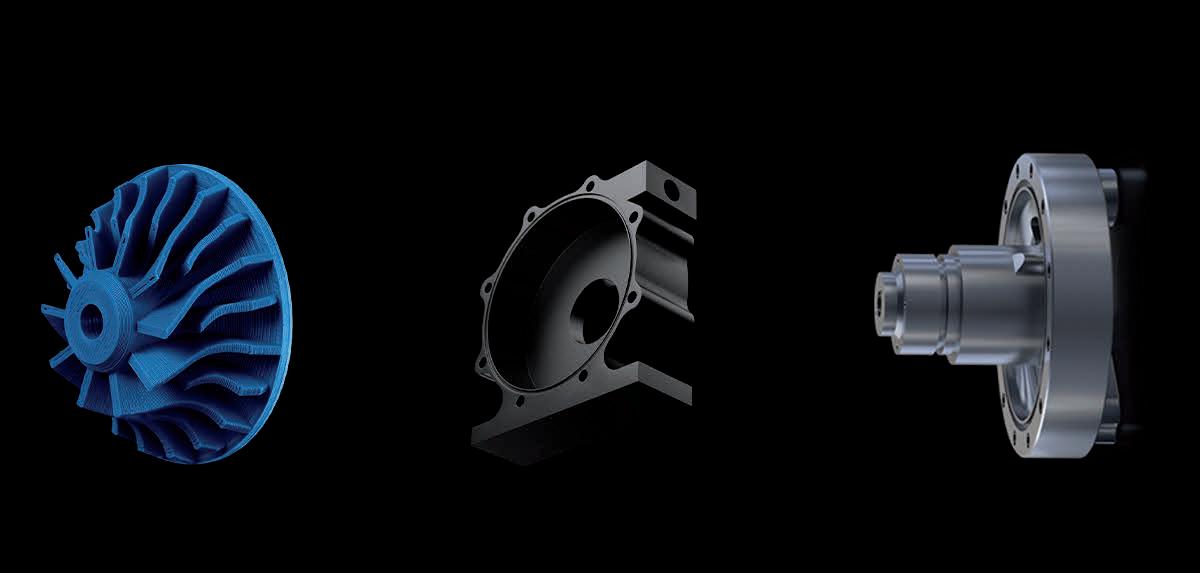
Claim your Complimentary 3D Printed Part* by simply scanning the QR code and filling out the form. Our Engineers will be in touch!

* T&C Only organizations with relevant use cases qualify for the Complimentary 3D Printed Part at the discretion of the Markforged Application Engineer. By subscribing to the Complimentary 3D Printed Part campaign you agree for Markforged to use the part for marketing purposes. Offer valid in Australia.
Get
































































































